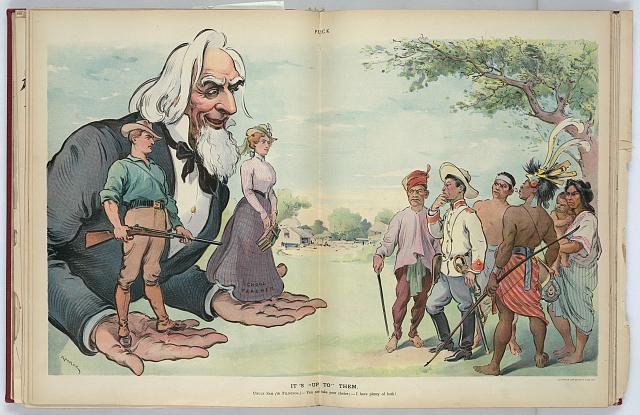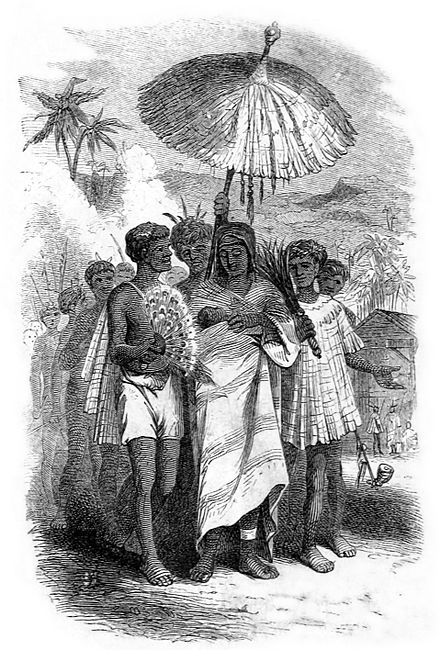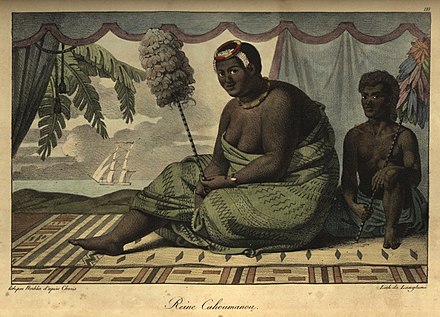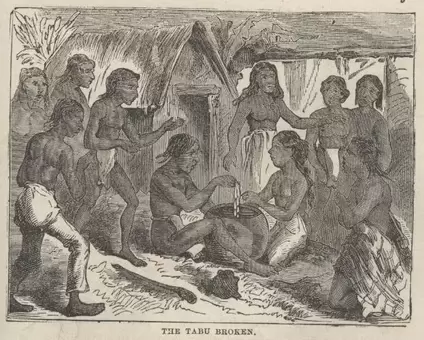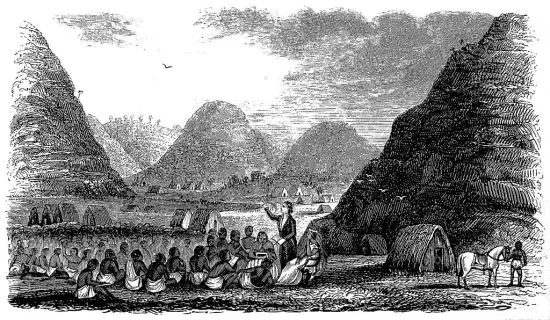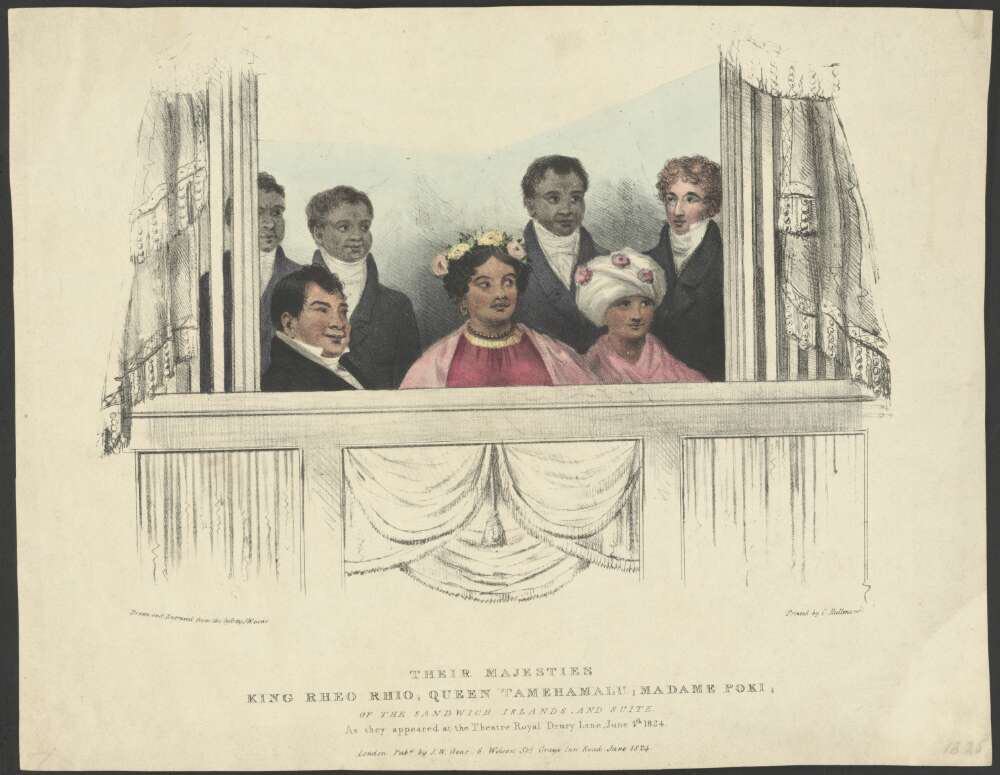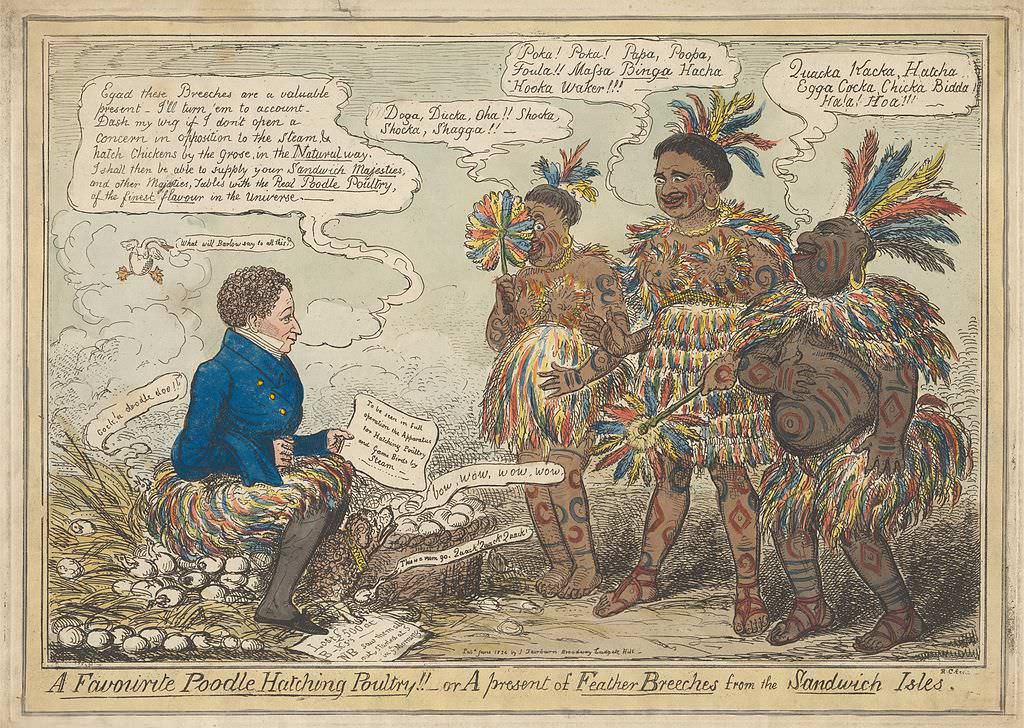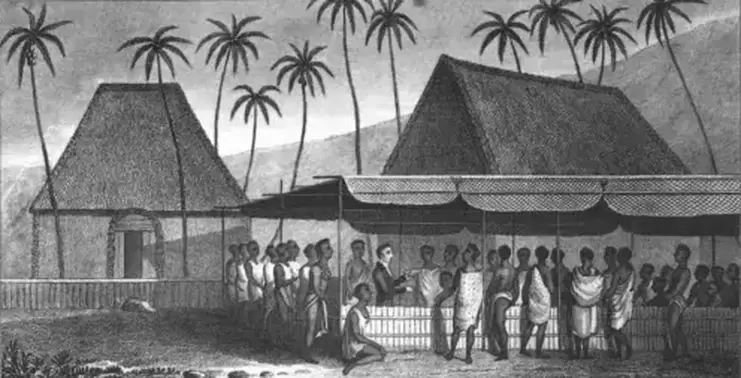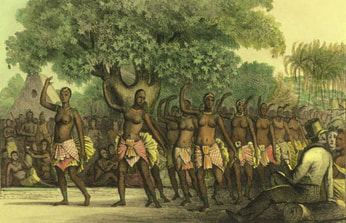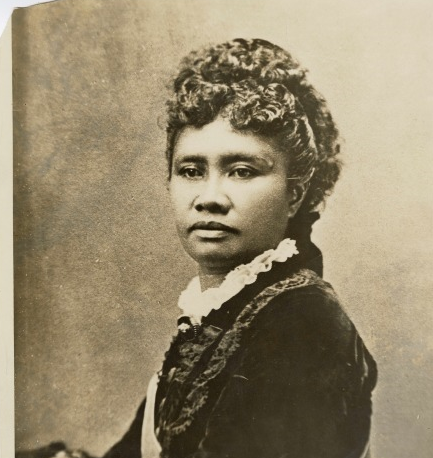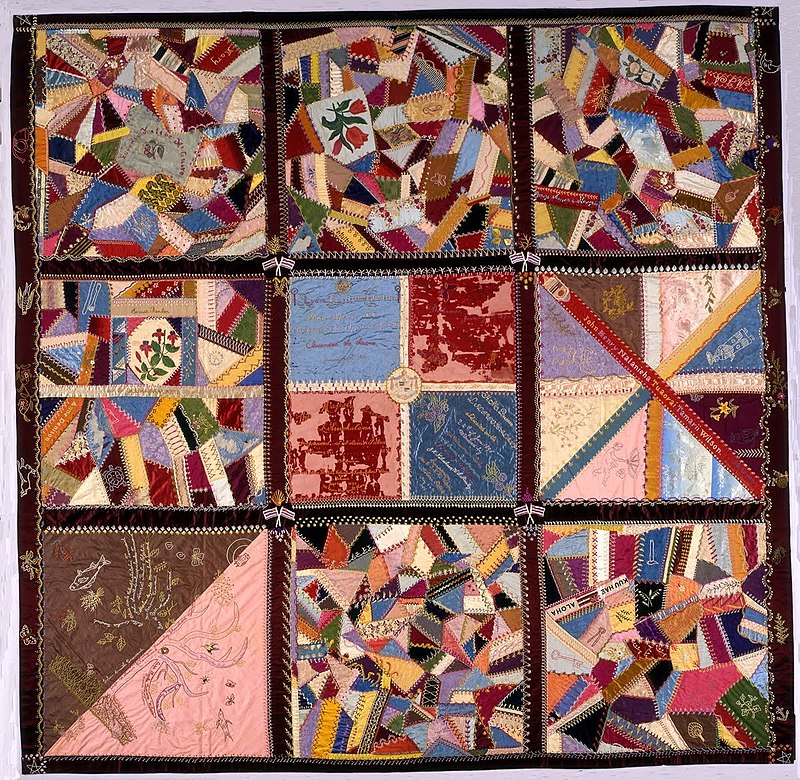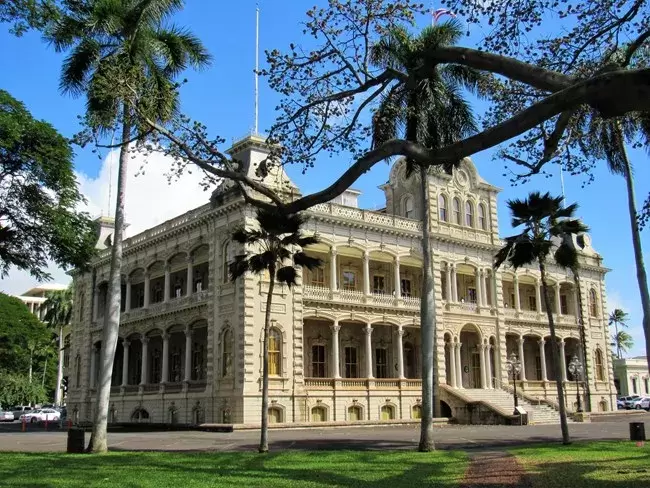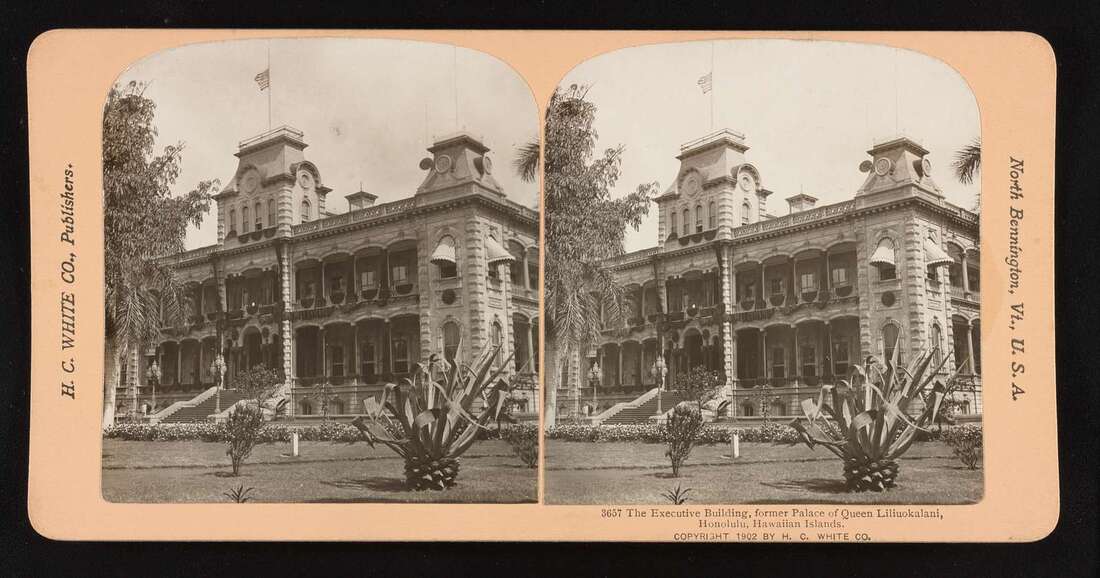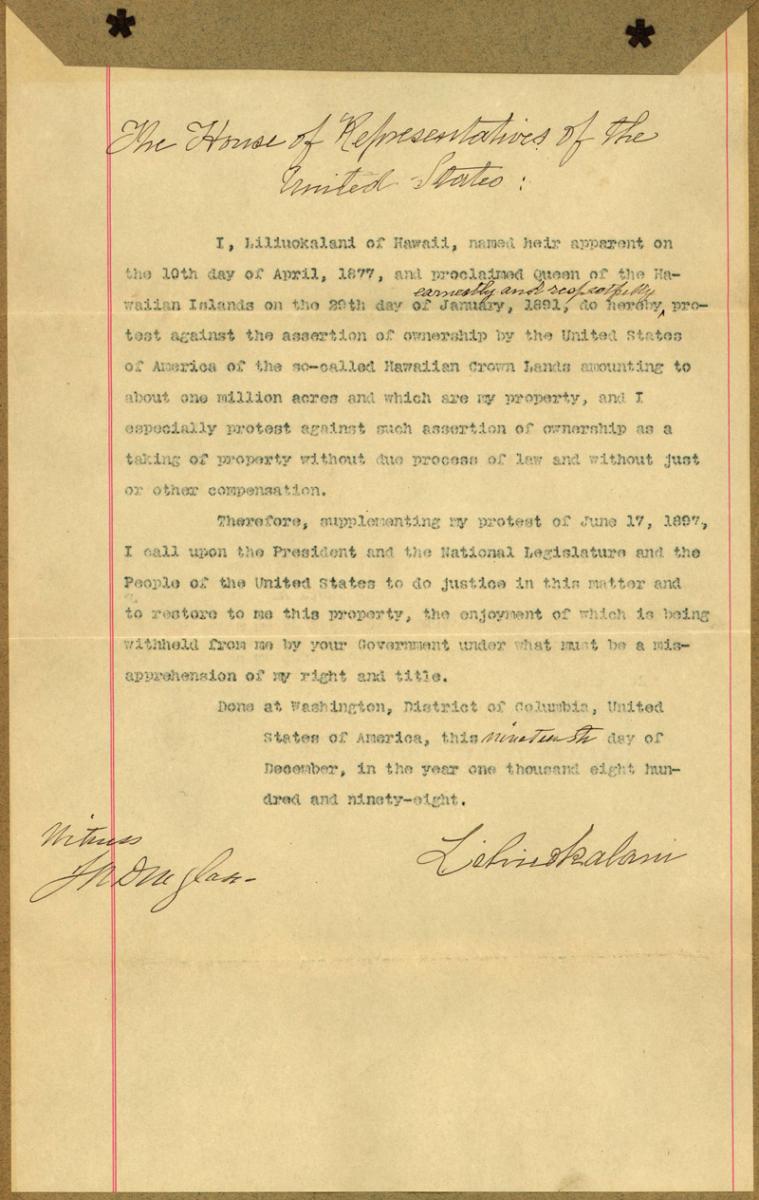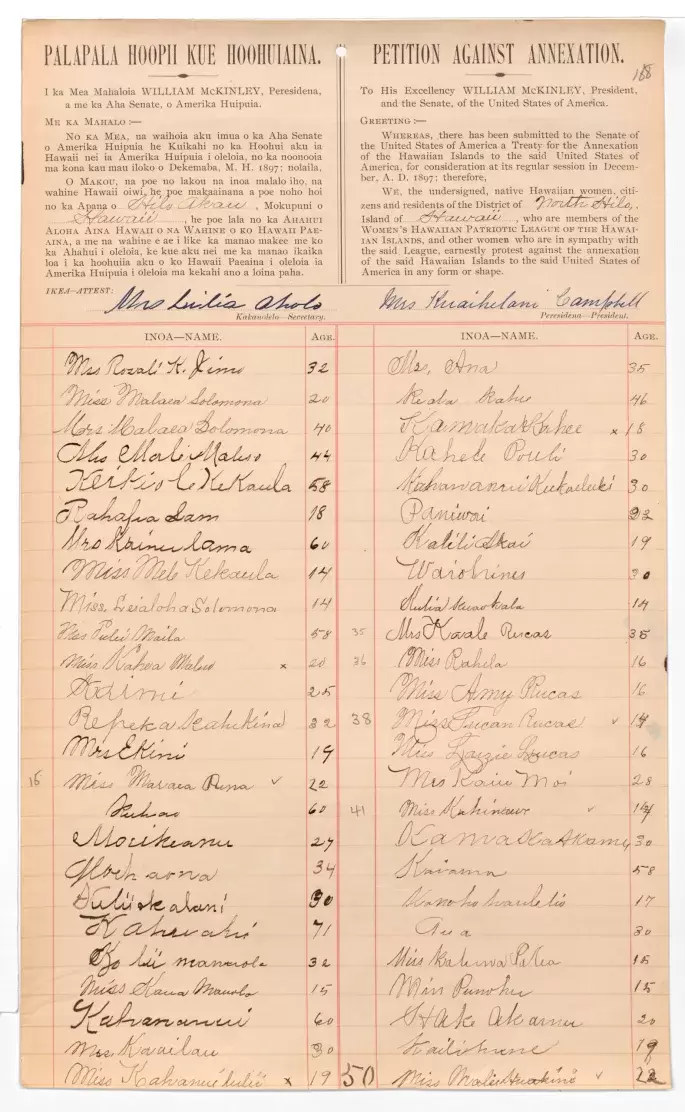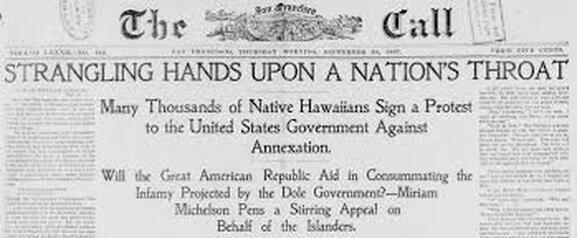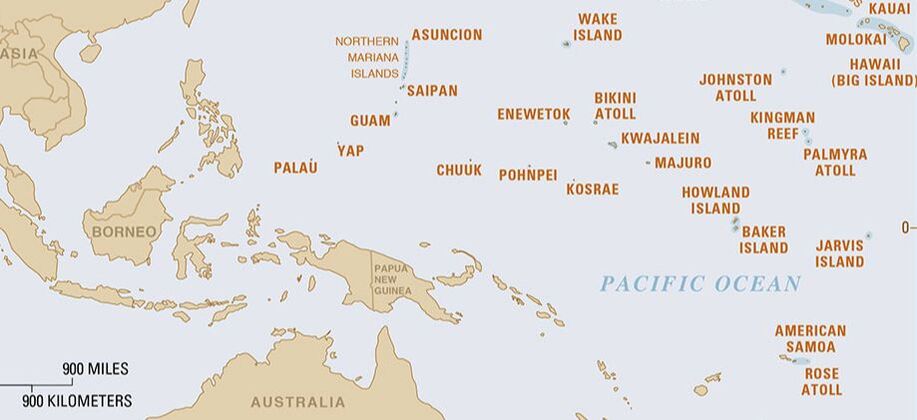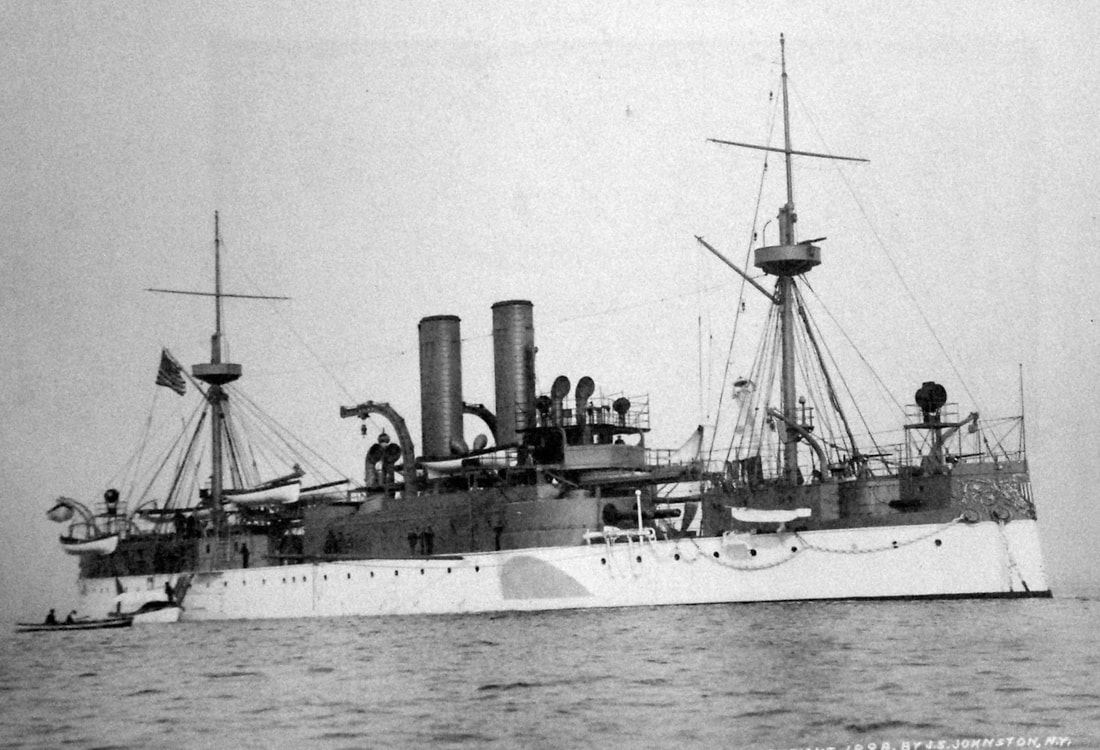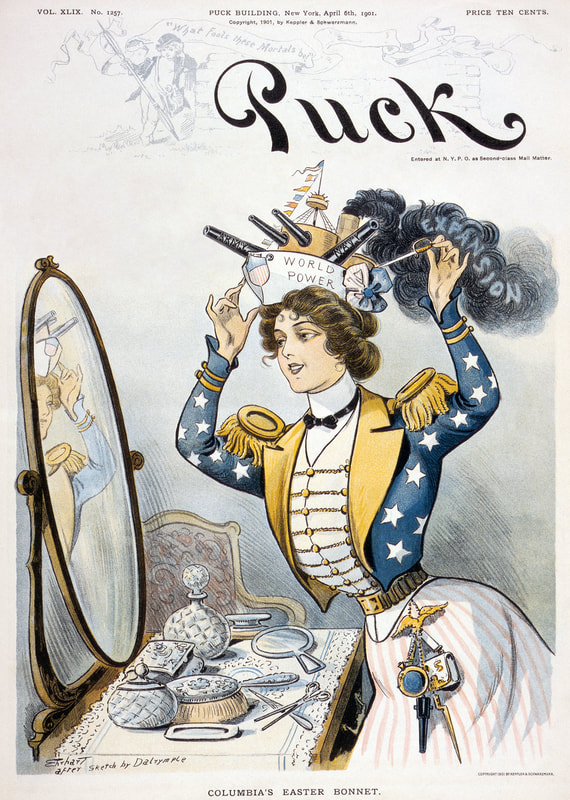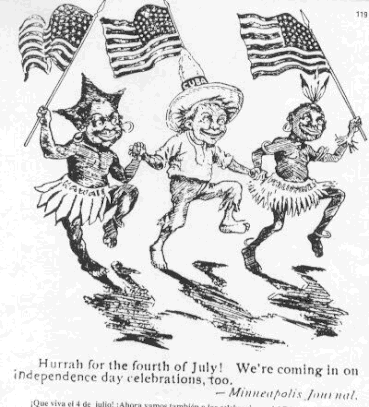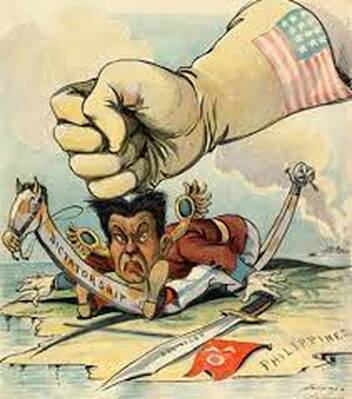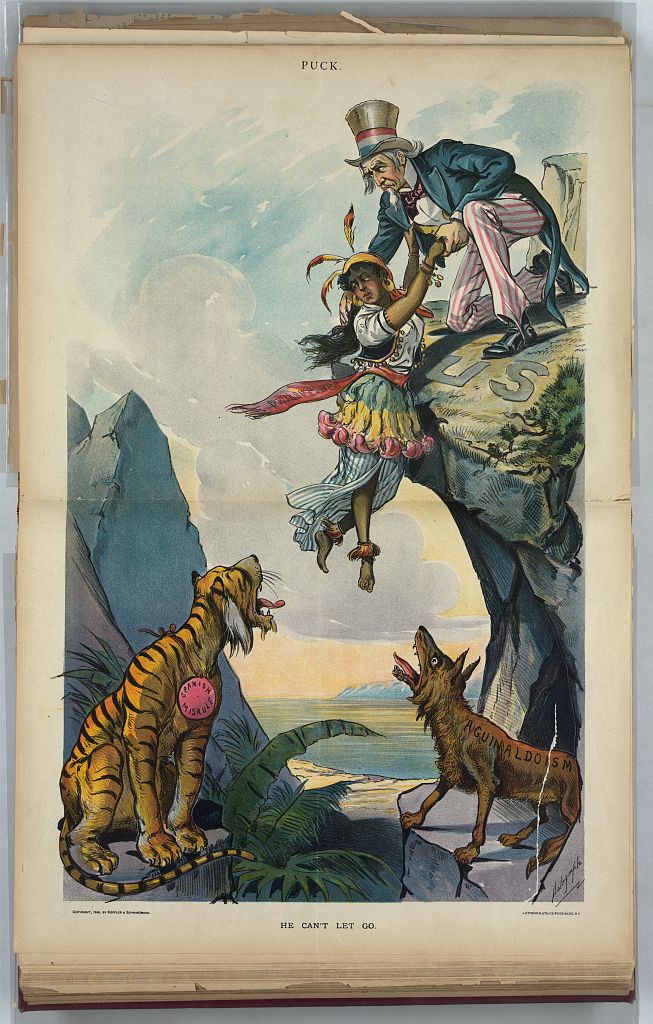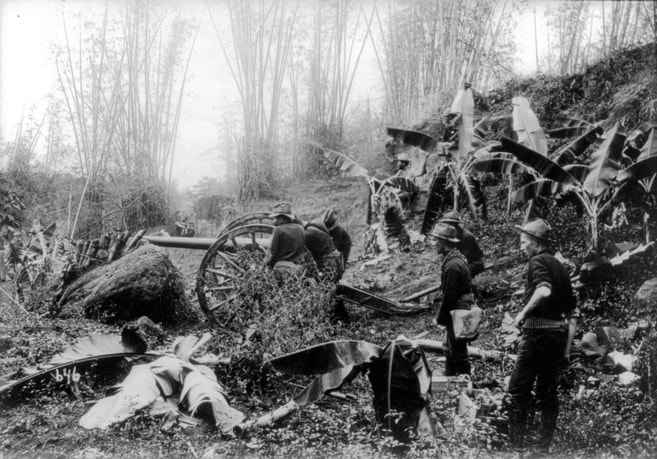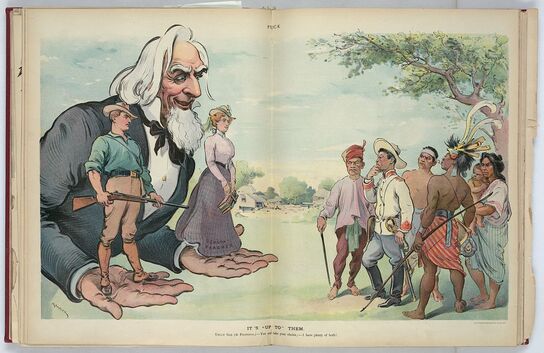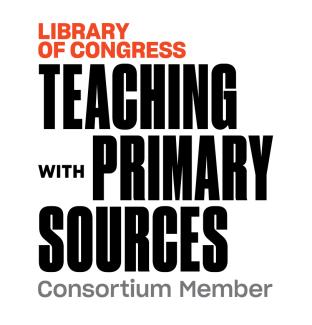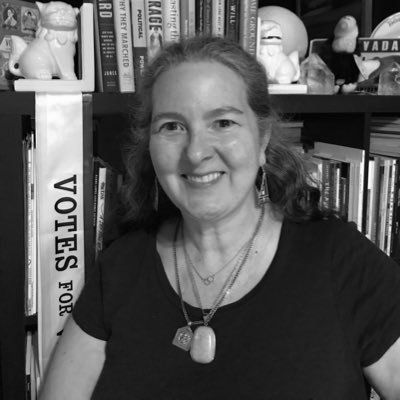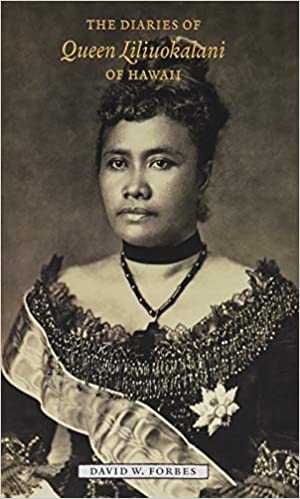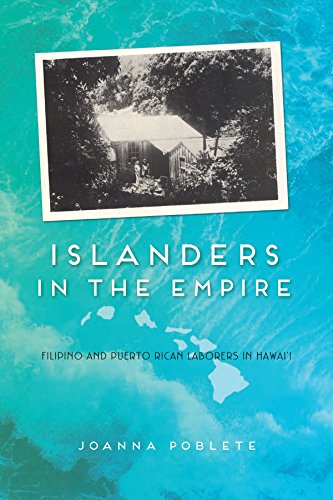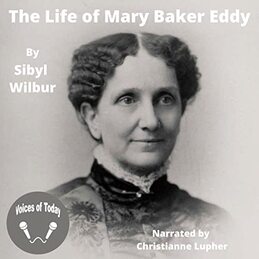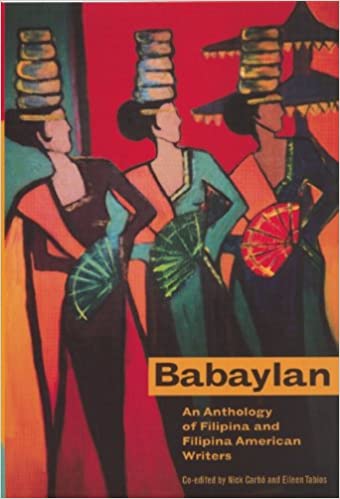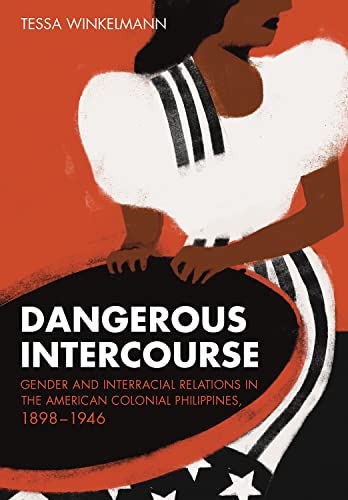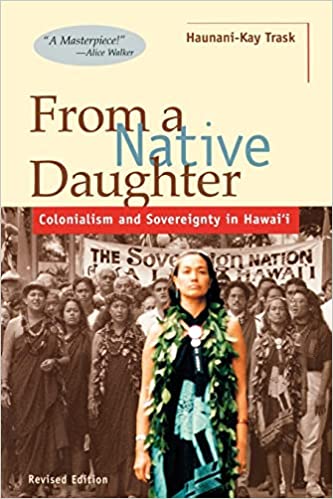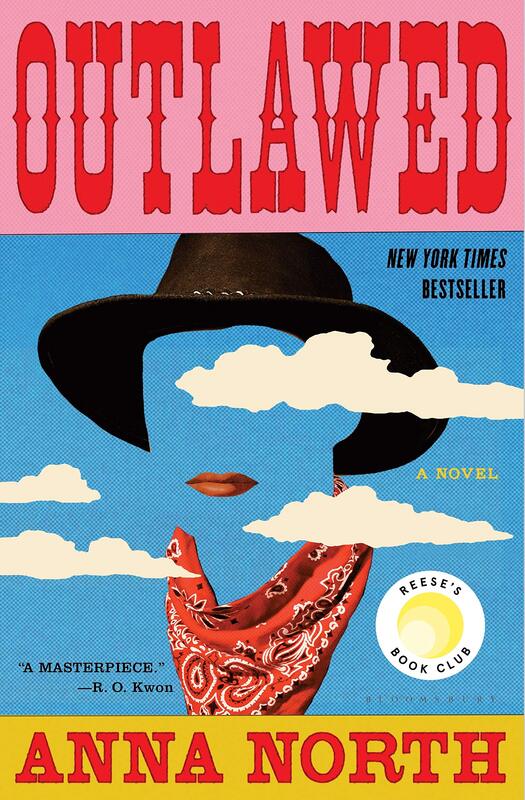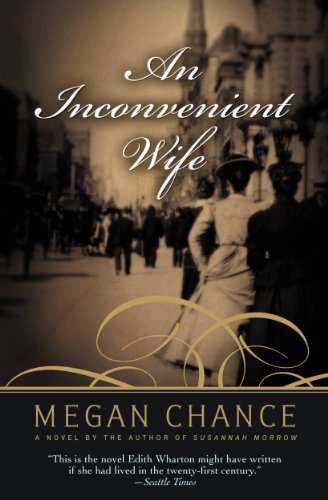12. Women and Expansion
|
Where US imperialism went, so did women, and of course women were already in places where the US went. US imperialists gave indigenous people they encountered two choices: the male soldier, or the female teacher. They were going to Americanize them one way or the other. Indigenous people responded differently depending on the location and their unique history. Two great examples are US imperialism in Hawaii and the Philippines, where important and powerful women resisted US expansion, all while American women took up the "White-Woman's Burden."
|
When the Civil War ended, America could turn outward again. The islands in the Pacific dotting the path to China were alluring. As were the raw materials in the Caribbean and South American countries only recently freed from Spanish colonization. So while men in government devised plans to conquer these places, white women were instrumental in the implementation and efficacy of American imperialism. On the receiving end, women were both victims and resistors of American imperialism. To understand more deeply, this episode will explore and contrast the experiences of women in Hawaii and the Philippines. Both nations were annexed, one peacefully, the other violently. As always, when we discuss armed conflict, sexual violence against women is present, so trigger warning for discussion of rape and sexual assault.
American imperialism in the Americas and Pacific goes back before the Civil War. In the 1820s and 30s missionaries traveled to distant places to uplift and Christianize the indigenous people that lived there. Their goal was to convert these “heathens'' and help them embrace a Western, Christian lifestyle. People believed that male missionaries, traveling without a wife, would be unable to resist the exotic women they encountered abroad, so married men were preferred. These ceremonies were often rushed with husband and wife knowing very little about one another before being shipped to some remote location. Sybil Moseley Bingham married her husband after only knowing him a couple of weeks. They sailed to Hawaii 12 days after they were married! Bingham wrote in her journal, "I believe God appoints my work… and it is enough for me to see that I do it all with an eye to his glory." What’s important here is that white women were seen as essential to the success of the mission because they would civilize the men. They were also complicit in religious imperialism, not just bystanders.
American imperialism in the Americas and Pacific goes back before the Civil War. In the 1820s and 30s missionaries traveled to distant places to uplift and Christianize the indigenous people that lived there. Their goal was to convert these “heathens'' and help them embrace a Western, Christian lifestyle. People believed that male missionaries, traveling without a wife, would be unable to resist the exotic women they encountered abroad, so married men were preferred. These ceremonies were often rushed with husband and wife knowing very little about one another before being shipped to some remote location. Sybil Moseley Bingham married her husband after only knowing him a couple of weeks. They sailed to Hawaii 12 days after they were married! Bingham wrote in her journal, "I believe God appoints my work… and it is enough for me to see that I do it all with an eye to his glory." What’s important here is that white women were seen as essential to the success of the mission because they would civilize the men. They were also complicit in religious imperialism, not just bystanders.
|
A powerful visual of the role that women played during US imperialism is that of Uncle Sam, holding up an American soldier and an American teacher. The inhabitants of these various islands are faced with a choice: war or education. Gendered analysis about the male soldier and the female teacher notwithstanding, the takeaway is that women were being mobilized for a different kind of imperialism. Due to prevailing gender norms, women were expected to provide for the education of children. In the case of imperialism, education was weaponized as a tool to strip these indigenous people of their traditions, culture, and heritage and replace them with a white, Christian, American version of democracy.
|
|
Hawaii:
The islands of Hawaii are a powerful example not only of US imperialism, but of the patriarchal US overthrowing a kingdom of powerful women. To illustrate this it’s important to back up. Polynesian people navigated to the islands of Hawaii in the early middle ages using only the stars. Unique cultures emerged on each of the islands. British explorer James Cook landed with his team in Hawaii becoming the first European known to have landed. He was killed by the Hawaiians a year later while trying to kidnap the king of the island Hawaii. His presence and the strength of his vessels were a bitter warning to the Hawaiians of their military weakness by comparison. The Hawaiians worked to unify the surrounding islands and by 1810, under the reign of King Kamehameha I, they were successful. One of the major conquests was his victory over the island of Maui in 1790 while the island’s King was away at Oahu. Keōpuolani, a descendant of the King whose subjects killed James Cook, the current King’s grand-niece and interestingly also the niece of Kamehameha, was just 11 years old during the conflict, yet she played a crucial role in unifying Hawaii. |
She and other royal family members fled Kamehameha’s attack. Her grandmother, Kalola fell sick as they fled and they stopped to rest, but the two women and their entourage were taken captive. Kalola was forced to offer her granddaughter as a future bride to Kamehameha in order to secure peace. Maui came under the rule of a unified Hawaii and 11-year old Keōpuolani awaited marriage to her mom’s half-brother.
Keōpuolani & Ka’ahumanu:
That said, Keōpuolani became the highest ranking wife of Kamehameha when they married five years later, giving her immense power over the newly unified islands. She gave birth to at least 11 children, but only 3 survived to adulthood and two went on to be kings. Her children were considered sacred, so sacred Kemehameha would lie on his back and place them on his chest as a sign of their superiority to him. In Hawaiian tradition, her children were taken away to be educated by others. But Keōpuolani broke this tradition with her daughter, Nāhienaena. She was not a very politically involved woman and deferred to Kamehameha’s favorite wife Kaʻahumanu.
Keōpuolani & Ka’ahumanu:
That said, Keōpuolani became the highest ranking wife of Kamehameha when they married five years later, giving her immense power over the newly unified islands. She gave birth to at least 11 children, but only 3 survived to adulthood and two went on to be kings. Her children were considered sacred, so sacred Kemehameha would lie on his back and place them on his chest as a sign of their superiority to him. In Hawaiian tradition, her children were taken away to be educated by others. But Keōpuolani broke this tradition with her daughter, Nāhienaena. She was not a very politically involved woman and deferred to Kamehameha’s favorite wife Kaʻahumanu.
|
Around the world, in 1808, Obookiah, a Hawaiian man traveled to Connecticut and converted to Christianity, convincing New Englanders of the necessity to travel to these distant islands to help convert the “heathen.” Before he could return home he died, and his memoir became a best seller in New England. Christian Missionaries departed Boston in 1819, but since these men were required to be married, many hastily married–with four weddings taking place before departure. These white Christian newlyweds arrived in Hawaii in 1820.
|
On the islands, Kaʻahumanu had become regent to Keōpuolani’s son after Kamehameha died. Their roles were essentially King and Prime Minister. In the aftermath of Kamehameha’s death, she was instrumental in putting down a rebellion from the island Kauaʻi by capturing the island's leader and forcing him to marry her. When he died, she captured his son and made him marry her too. The kingdom secured, Ka'ahumanu went about a plan to modernize and solidify her influence.
|
She colluded with Keōpuolani to overthrow the Hawaiian kapu system, which banned women from eating meals with men. Violations of kapu, which were an ancient system of traditions, were punishable by immediate death. Kamehameha declined to kill them and they were not punished by the gods, thus the kapu was broken. The women solidified, literally, their place at the table as Christian missionaries arrived.
The white, New England missionaries were a sight to see in Hawaii. Similarly, they were shocked by the bare bodies of the native Hawaiians. |
They set to work building New England-style frame houses, which looked odd on the beaches of Hawaii, and a church. They helped the Hawaiians craft a written language and created a reading primer in Hawaiian. To aid in their mission, they translated the Bible and preached Christian ideas.
The Hawaiians had little interest in what the missionaries found important. Hawaiians were hunters and foragers, the New Englanders were farmers. Hawaiians wore very little clothing, still the New Englanders taught them to sew. But since traditional Hawaiian religion was already declining, this was a way the missionaries could build connections.
The Hawaiians had little interest in what the missionaries found important. Hawaiians were hunters and foragers, the New Englanders were farmers. Hawaiians wore very little clothing, still the New Englanders taught them to sew. But since traditional Hawaiian religion was already declining, this was a way the missionaries could build connections.
|
Seeing the power of Christian Britain and the United States and inspired by Christianity, Keōpūolani and Kaʻahumanu converted to Protestant Christianity in 1823 and 1824 respectively, setting an example for other Hawaiians They also adopted western style dress. As regent, Ka’ahumanu also crafted Hawaii’s first codified laws. She took the western name "Elizabeth" when she was baptized a year later. Against her wishes, Kamehameha II and his wife traveled to Britain for an audience with the King in hopes of building a stronger alliance. But like other native peoples who traveled to Europe (think Pocahontas), they both died in the summer of 1824 from measles to which they had no immunity.
|
American Missionaries:
Ka’ahumanu stayed on as regent of Kamehameha II, further cementing her power and influence. In 1830, she banned the Hula and as part of her path toward Christinizing and westernizing Hawaii. The Hula was and is a sensual mimetic religious dance performed before the king to honor the gods or praise the chief. It was a symbol of polytheism in a rapidly Christianizing Hawaii. She and the king negotiated treaties with the encroaching American businessmen who had sugar and pineapple plantations on the island, granting them free trade on the islands and the opportunity to represent themselves in Hawaiian courts– a dangerous move.
The Americans and the missionaries thought little of the Hawaiian people. Maria Loomis wrote in 1820: “Indolence may be considered as a native characteristic. Little to excite them to action they spend many precious hours in sleep. Their women do no work of any consequence, they think it rather a disgrace.” Her condemnation of the “lazy Hawaiians” reveals how little she understood their culture.
Mary Chapin, wrote in 1832: "Is this that land of heathenish darkness, where gods which their own hands had made usurped this way—where the true God was not known? Is Jesus formed and living here?" She was obviously discouraged and frustrated at this clash of cultures. But, two months later, she gradually admitted "Although much enlightened, still they are ignorant people, and need much instruction.”
Ka’ahumanu stayed on as regent of Kamehameha II, further cementing her power and influence. In 1830, she banned the Hula and as part of her path toward Christinizing and westernizing Hawaii. The Hula was and is a sensual mimetic religious dance performed before the king to honor the gods or praise the chief. It was a symbol of polytheism in a rapidly Christianizing Hawaii. She and the king negotiated treaties with the encroaching American businessmen who had sugar and pineapple plantations on the island, granting them free trade on the islands and the opportunity to represent themselves in Hawaiian courts– a dangerous move.
The Americans and the missionaries thought little of the Hawaiian people. Maria Loomis wrote in 1820: “Indolence may be considered as a native characteristic. Little to excite them to action they spend many precious hours in sleep. Their women do no work of any consequence, they think it rather a disgrace.” Her condemnation of the “lazy Hawaiians” reveals how little she understood their culture.
Mary Chapin, wrote in 1832: "Is this that land of heathenish darkness, where gods which their own hands had made usurped this way—where the true God was not known? Is Jesus formed and living here?" She was obviously discouraged and frustrated at this clash of cultures. But, two months later, she gradually admitted "Although much enlightened, still they are ignorant people, and need much instruction.”
There was clearly a difference between the desires of the elites in Hawaii and the average Hawaiians. The throne passed between Hawaiian monarchs several times, the traditional monarchy was replaced by a constitutional monarchy, relations with Americans became tense, and the throne finally landed on Hawaii’s first and only female monarch: Queen Liliuokalani.
|
Liliuokalani:
Liliuokalani came to power after the death of her brother Kalakaua. He was elected to the Hawaiian throne under the new system and was forced to sign treaty after treaty with the United States that undermined Hawaiian autonomy over their own land. One treaty even allowed sugar to be sold to the US tax free. Still, white American businessmen distrusted the Hawaiian monarchy and worked to undermine it. One reason for their distrust was his revival of Hawaiian traditions they did not understand, like Hula. Under the threat of violence Kalakua was forced to accept a new constitution that stripped the monarchy of executive powers and put businessmen inside the executive cabinet– American democracy in action. The new constitution effectively disenfranchised native Hawaiian voters in favor of descendents of American businessmen and missionaries. He died in 1891, a diminished king, leaving his sister with an impossible situation. |
Lili'uokalani was bold as heck and drafted a new constitution to restore native rights and powers. In response, an executive committee that was tasked with deciding whether Hawaii should become part of the US, a process called “Annexation” brought in the big guns, literally. Marines off the warship USS Boston surrounded the Queens palace and placed her under house arrest in a bloodless coup in 1893. While there she spent her days looking out upon her kingdom and sewing a vast quilt that told her story. She later wrote an autobiography about that experience. She said, “That first night of my imprisonment was the longest night I have ever passed in my life; it seemed as though the dawn of day would never come. I found in my bag a small Book of Common Prayer… It was a great comfort to me."
Now this was an interesting event even from a US perspective. This coup was performed without express permission from the US State Department. Within the US, annexation of new lands was hotly debated. Americans supported missionary work and expansion of US power, but deeply embedded racism led many to fear the inclusion of so many indigenous people. Despite this, American President Benjamin Harrison signed the treaty, but before the Senate could approve it, Grover Cleveland replaced him as president and withdrew the treaty. Cleveland was anti-imperialism and demanded an investigation into US actions in Hawaii. They found that Americans were in the wrong and ordered them to lower the US flag from Hawaiian buildings, and restore Queen Liliuokalani to power. But the new Hawaiian president, Sanford Dole, the descendent of missionaries and owner of a large pineapple plantation, refused arguing the US had no right to meddle in Hawaiian affairs. The Provisional Government proclaimed Hawaii a republic in 1894, later recognized by the United States.
Queen Liliuokalani wrote of this experience: “a paper was handed to me… which, on examination, proved to be a purported act of abdication for me to sign. It had been drawn out for the men in power by their own lawyer… For myself, I would have chosen death rather than to have signed it; but it was represented to me that by my signing this paper all the persons who had been arrested, all my people now in trouble by reason of their love and loyalty towards me, would be immediately released. Think of my position, – sick, a lone woman in prison, scarcely knowing who was my friend, or who listened to my words only to betray me, without legal advice or friendly counsel, and the stream of blood ready to flow unless it was stayed by my pen."
Queen Liliuokalani wrote of this experience: “a paper was handed to me… which, on examination, proved to be a purported act of abdication for me to sign. It had been drawn out for the men in power by their own lawyer… For myself, I would have chosen death rather than to have signed it; but it was represented to me that by my signing this paper all the persons who had been arrested, all my people now in trouble by reason of their love and loyalty towards me, would be immediately released. Think of my position, – sick, a lone woman in prison, scarcely knowing who was my friend, or who listened to my words only to betray me, without legal advice or friendly counsel, and the stream of blood ready to flow unless it was stayed by my pen."
|
Her overthrow was against the will of the Hawaiian people. Native Hawaiians staged mass protests against the overthrow and to prevent the likely annexation. Protests morphed into an overthrow attempt in 1895. The leaders and Queen Liliuokalani were temporarily jailed and in March of 1897 the imperialist president from a far off land, William McKinley, signed a treaty of annexation.
Before it could be ratified, Queen Liliuokalani herself traveled to Washington, DC, to rally against annexation. Women embedded in the protest groups back in Hawaii worked tirelessly to petition the US government. Their petitions were signed by 21,269 native Hawaiian people, more than half the native Hawaiians, but nothing changed. Queen Liliuokalani wrote: “I have never expected the revolutionists of 1887 and 1893 to willingly restore the rights notoriously taken by force or intimidation; but this act, obtained under duress, should have no weight with the authorities of the United States, to whom I appealed.” Unfortunately, it did. Although the US apologized for the overthrow of Queen Liliuokalani a hundred years later under President Clinton, no steps have been taken to separate Hawaii from US control. |
|
US Annexation was justified among Americans as a proper way to uplift and Christianize these unknown people in a far off land. Americans knew little of Hawaii, and definitely did not know that Hawaiians were already Christian and that the Queen's palace included more modern features than the White House. These weren’t backward people. Queen Liliuokalani wrote of this hypocrisy. She said: “And where else in the world's history is it written that a savage people, pagan for ages, with fixed hereditary customs and beliefs, have made equal progress in civilization and Christianity in the same space of time? And what people has ever been subjected during such an evolution to such a flood of external demoralizing influences? Does it make nothing for us that we have always recognized our Christian teachers as worthy of authority in our councils, and repudiated those whose influence or character was vicious or irreligious? That while four-fifths of the population of our Islands was swept out of existence by the vices introduced by foreigners, the ruling class clung to Christian morality, and gave its unvarying support and service to the work of saving and civilizing the masses?” Despite her losses, Queen Liliuokalani never failed to speak truth to power.
|
US imperialism in Hawaii was bloodless. It involved the work of countless women teaching reading and writing, spreading faith and integrating themselves and their families into Hawaiian lands, businesses, and culture. The effect was the same: indigenous people were stripped of their autonomy over their own lands. It is the only case in this period of US imperialism where the US overthrew a recognized and legitimate constitutional monarchy.
|
Philippines:
Hawaii was a strategic refuel station for the American Navy, whose eyes were set on the Philippines, but unlike Hawaii, US annexation would not be bloodless. Tensions between the US and Spain had been rising for a century. Spanish control over territories like Cuba were frustrating given the proximity to the US sphere of influence. Spanish treatment of the Cubans was growing increasingly hostile as the Cubans demanded independence, and the US supported them in their goal. In 1898, the United States went to war with Spain after the USS Maine accidentally exploded off the coast of Havana, Cuba. The American media blamed the explosion on Spain. But then US intentions became clear: control of the Philippines. Spain had long colonized the Philippines. American ships departed from San Francisco within hours of the explosion in Havana to assist the Filipinos in their independence struggles against Spain that had raged since before 1896. The leader in charge of Philippine resistance was Emilio Aguinaldo, a temporary dictator operating under the title of president. William McKinley referred to American imperialism as “benevolent assimilation,” but US actions were far from benevolent. He sent American women to the Philippines and elsewhere to convince the world that their intentions were good. Women were seen as passive and mothering and thus benevolent. These white women, symbolizing innocence abroad, were central to the imperial mission. The assumption that all women adopted these gender norms proved problematic for US efforts to colonize the Philippines. |
|
Native Filipino women were characterized as children who needed a mother’s guidance: white women. As a result, white women living in the Philippines were granted some power and autonomy within the public, political sphere. Emily Bronson Conger, the wife of Colonel Arthur Latham Conger, described with disdain the Filipino women she encountered in her book An Ohio Woman in the Philippines. Similar to Hawaiian missionaries, she wrote: “So many of the women are deformed and unclean, both the makers and the sellers that it seemed utterly incongruous that they should handle the most delicate materials… in our happy country we do not think of seeing a whole class of people diseased or maimed. In the Philippines one seldom sees a well-formed person; or if the form is good, the face is disfigured by small-pox.” American imperialists like her, wrongly associated nakedness with “savageness.” American women used gendered concerns over the morality of Filipino women to position themselves for greater influence in society in a time when back home American women were debating and discussing women’s suffrage.
|
But not all American women held these notions of Filipino inferiority. Helen Calista Wilson, wrote about the horrors she observed in A Massachusettes Woman in the Philippines. She described a merciless American teacher whipping an indigenous Filipino boy for not attending schoolShe said, “The little fellow shrieked with the pain, and the other children, thoroughly frightened, stopped their ears, shut their eyes, and wept with him.” One can assume this was a pattern of behavior in such racially charged climates.
Philippine-American War:
After the defeat of Spain in 1898, the US bought the Philippines from Spain at the treaty meeting in Paris and annexed Puerto Rico and Guam. Instead of independence, the Philippines became an American territory, or colony, transferring one colonizer for another– in a very undemocratic process. For the Filipinos who fought alongside the Americans in that war, this was a betrayal. Aguinaldo had received advanced notice of the treaty and resumed fighting. A guerilla war ensued for the next 17 years. Filipino women and their families were both caught in the conflict and active participants in it.
After the defeat of Spain in 1898, the US bought the Philippines from Spain at the treaty meeting in Paris and annexed Puerto Rico and Guam. Instead of independence, the Philippines became an American territory, or colony, transferring one colonizer for another– in a very undemocratic process. For the Filipinos who fought alongside the Americans in that war, this was a betrayal. Aguinaldo had received advanced notice of the treaty and resumed fighting. A guerilla war ensued for the next 17 years. Filipino women and their families were both caught in the conflict and active participants in it.
|
In 1899, Rudyard Kipling looked back on four centuries of British imperialism and encouraged the rising American empire to do the same. He wrote:
“Take up the White Man’s burden-- Send forth the best ye breed-- Go send your sons to exile To serve your captives' need” His use of masculine terms ignored the fact that white women joined the “sons” in “exile.” In exile, or robust, often Christian, cities, Filipino women lived among the invaders and refused to submit. Filipino women were caught between competing Filipino and American definitions of masculinity. They were active agents in their society serving in the public sphere as shopkeepers, saloon operators, and in brothels. At the forefront of many economic transactions with American service men and formed a sort of active resistance against them. When servicemen cheated them out of money, they raised prices. Americans remarked that women operated most of the businesses, but his observation is hard to take at face value because emasculating foreign men by saying their wives did everything was also a tool of imperialists. |
A cartoonist in the Philippines captured this perfectly with a quip about Filipino male laziness. Portraying two women doing all the work while the men sit in the background, he wrote, “Why make a fuss about the ‘White Man’s Burden’? The native girls did not.” Clearly gender norms differed within these societies and Filipino women were caught in the middle.
As often happens in war zones, Filipino and American women earned money as prostitutes. Sexually transmitted diseases were rampant in both the American and Filipino forces, so instead of finding alternative sources of income for these women, they decided to subject the Filipino women, not men or white women to demeaning inspections. Filipino women of course resisted by forging documents, hiding among civilians, and disappearing when inspectors came by.
As often happens in war zones, Filipino and American women earned money as prostitutes. Sexually transmitted diseases were rampant in both the American and Filipino forces, so instead of finding alternative sources of income for these women, they decided to subject the Filipino women, not men or white women to demeaning inspections. Filipino women of course resisted by forging documents, hiding among civilians, and disappearing when inspectors came by.
Women's Resistance:
Filipino women resisted US occupation of the Philippines militarily as well. Some estimates suggest that one in ten guerilla insurgents was a woman. American men, heavily influenced by traditional gender norms, did not suspect the active resistance of Filipino women who helped move weapons, funnel escapees, and undermine US control on the islands. American officials concealed women’s involvement by insisting the continued resistance was due to a few male leaders, not a general resistance from an outraged population sick of colonial rule.
Living in a war zone was chaos, though, and rarely do women as a group fare well. There were reports of individual men seizing and holding Filipino women as personal sex slaves. Caught in a time and place where usual law and order protections were abandoned for military strategy, these women experienced unimaginable horror. Women were often spotted carrying weapons through the countryside where most of the fighting occurred, this was more likely for personal protection than for the overall military strategy. One woman who was not able to defend herself was stabbed 13 times by fellow Filipinos who had aligned with the US.
For American soldiers, the conflict was complicated. Caught up in the prevailing racism many contributed to the horrors while others were repulsed by it. For Black soldiers, the war was complicated because they were fighting an enemy with dark skin degraded by white men with similar words. One soldier wrote home to his parents about the plight of civilians: “The town… was surrendered to us a few days ago, and the two companies to occupy the same. Last night one of our boys was found shot and his stomach cut open. Immediately orders were received from General Wheaton to burn the town and kill every native in sight; which was done to a finish. About 1,000 men, women and children were reported killed. I am probably growing hard-hearted, for I am in my glory when I can sight my own gun on some dark skin and pull the trigger."
Filipino women resisted US occupation of the Philippines militarily as well. Some estimates suggest that one in ten guerilla insurgents was a woman. American men, heavily influenced by traditional gender norms, did not suspect the active resistance of Filipino women who helped move weapons, funnel escapees, and undermine US control on the islands. American officials concealed women’s involvement by insisting the continued resistance was due to a few male leaders, not a general resistance from an outraged population sick of colonial rule.
Living in a war zone was chaos, though, and rarely do women as a group fare well. There were reports of individual men seizing and holding Filipino women as personal sex slaves. Caught in a time and place where usual law and order protections were abandoned for military strategy, these women experienced unimaginable horror. Women were often spotted carrying weapons through the countryside where most of the fighting occurred, this was more likely for personal protection than for the overall military strategy. One woman who was not able to defend herself was stabbed 13 times by fellow Filipinos who had aligned with the US.
For American soldiers, the conflict was complicated. Caught up in the prevailing racism many contributed to the horrors while others were repulsed by it. For Black soldiers, the war was complicated because they were fighting an enemy with dark skin degraded by white men with similar words. One soldier wrote home to his parents about the plight of civilians: “The town… was surrendered to us a few days ago, and the two companies to occupy the same. Last night one of our boys was found shot and his stomach cut open. Immediately orders were received from General Wheaton to burn the town and kill every native in sight; which was done to a finish. About 1,000 men, women and children were reported killed. I am probably growing hard-hearted, for I am in my glory when I can sight my own gun on some dark skin and pull the trigger."
"Over our blood and our dead bodies": In 1899, Filipino women crafted a poem of resistance that was widely published. They said:
“When, when at every house they enter,
Should they violate every woman they capture?
These are the acts of brutality in war.
This is the height of cruelty in battle.
Let us fight for our independence
And struggle, till the last fighter breathes
Never again should we let anyone conquer us
Over our blood and over our dead bodies.”
Their position was clear. Their struggle was one of personal defense as well as Philippine nationalism and they were not backing down. Women in rural areas faced unimaginable dangers as scorched earth tactics were used to route out Filipino insurgents. Entire villages were burned to the ground and survivors were forced into occupied territories as refugees.
Aginaldo’s wife, Hilaria del Rosario, was the head of the Philippines Red Cross during the war and also held extreme nationalistic perspectives. She wrote: “We must, therefore, think of the best means to defend our Philippine country, even by treacherously, killing them, one by one which, in the long run, will exterminate them, since we are short of arms, and have sufficient rights. Although we are women, we can aid you.” Women helped the resistance by hiding supplies and weapons in their homes. One woman who’s home was in sight of the American base was arrested, although she resisted in an epic brawl, and became one of only two women actually discovered for espionage work. Another mistress helped funnel funds from the city to the guerillas fighting outside. Although a trial took place, Americans were reluctant to try the woman, who had clearly been the instigator in this case. Women across the Philippines continued to resist colonization through the end of the war using strategic military tactics not taken seriously by the Americans.
The situation in the Philippines calmed after Emilio Aguinado was taken captive by the US. The US remained in control of the Philippines until it lost the islands at the outset of WWII. The Japanese attacks on both Hawaii and the Philippines taught the indigenous populations a bitter lesson in the limits of US protections. Aguinaldo embraced the Japanese, whom he imagined would finally give the Philippines their independence. After the war, the new, independent, Philippine republic rejected him as their future president.
“When, when at every house they enter,
Should they violate every woman they capture?
These are the acts of brutality in war.
This is the height of cruelty in battle.
Let us fight for our independence
And struggle, till the last fighter breathes
Never again should we let anyone conquer us
Over our blood and over our dead bodies.”
Their position was clear. Their struggle was one of personal defense as well as Philippine nationalism and they were not backing down. Women in rural areas faced unimaginable dangers as scorched earth tactics were used to route out Filipino insurgents. Entire villages were burned to the ground and survivors were forced into occupied territories as refugees.
Aginaldo’s wife, Hilaria del Rosario, was the head of the Philippines Red Cross during the war and also held extreme nationalistic perspectives. She wrote: “We must, therefore, think of the best means to defend our Philippine country, even by treacherously, killing them, one by one which, in the long run, will exterminate them, since we are short of arms, and have sufficient rights. Although we are women, we can aid you.” Women helped the resistance by hiding supplies and weapons in their homes. One woman who’s home was in sight of the American base was arrested, although she resisted in an epic brawl, and became one of only two women actually discovered for espionage work. Another mistress helped funnel funds from the city to the guerillas fighting outside. Although a trial took place, Americans were reluctant to try the woman, who had clearly been the instigator in this case. Women across the Philippines continued to resist colonization through the end of the war using strategic military tactics not taken seriously by the Americans.
The situation in the Philippines calmed after Emilio Aguinado was taken captive by the US. The US remained in control of the Philippines until it lost the islands at the outset of WWII. The Japanese attacks on both Hawaii and the Philippines taught the indigenous populations a bitter lesson in the limits of US protections. Aguinaldo embraced the Japanese, whom he imagined would finally give the Philippines their independence. After the war, the new, independent, Philippine republic rejected him as their future president.
Conclusion:
Although different, US actions in Hawaii and the Philippines reflect a pattern of both passive and aggressive imperialist actions by the US government. Territories were given the choice: teachers or soldiers, and their selection determined US treatment. Women, as missionaries, wives, and teachers played instrumental roles in integrating American ideals on local populations that would later be used to seize power and land from the indigenous people. US actions in Hawaii and the Philippines were replicated in Puerto Rico, the Panama Canal, Guam, and elsewhere. Everywhere they misunderstood cultural differences on the roles of women, exploited, and seized land and power. Indigenous women found ways of resisting and enduring. Today, the Philippines thrive as an independent democracy, while Hawaii gained statehood after World War II. Puerto Rico and Guam remain as territories.
By the end of this era, so much remained in question. How would Hawaiian and Filipino women endure in these new governments? What would happen to the men and women in Guam, Puerto Rico, and other territories touched by the US in this period? And most importantly was there a third option the US did not consider in its haste for land?
Although different, US actions in Hawaii and the Philippines reflect a pattern of both passive and aggressive imperialist actions by the US government. Territories were given the choice: teachers or soldiers, and their selection determined US treatment. Women, as missionaries, wives, and teachers played instrumental roles in integrating American ideals on local populations that would later be used to seize power and land from the indigenous people. US actions in Hawaii and the Philippines were replicated in Puerto Rico, the Panama Canal, Guam, and elsewhere. Everywhere they misunderstood cultural differences on the roles of women, exploited, and seized land and power. Indigenous women found ways of resisting and enduring. Today, the Philippines thrive as an independent democracy, while Hawaii gained statehood after World War II. Puerto Rico and Guam remain as territories.
By the end of this era, so much remained in question. How would Hawaiian and Filipino women endure in these new governments? What would happen to the men and women in Guam, Puerto Rico, and other territories touched by the US in this period? And most importantly was there a third option the US did not consider in its haste for land?
Draw your own conclusions
|
Learn how to teach with inquiry.
Many of these lesson plans were sponsored in part by the Library of Congress Teaching with Primary Sources Eastern Region Program, coordinated by Waynesburg University, the History and Social Studies Education Faculty at Plymouth State University, and the Patrons of the Remedial Herstory Project. |
Lesson Plans from Other Organizations
- The National Women's History Museum has lesson plans on women's history.
- The Guilder Lehrman Institute for American History has lesson plans on women's history.
- The NY Historical Society has articles and classroom activities for teaching women's history.
- Unladylike 2020, in partnership with PBS, has primary sources to explore with students and outstanding videos on women from the Progressive era.
- The Roy Rosenzweig Center for History and New Media has produced recommendations for teaching women's history with primary sources and provided a collection of sources for world history. Check them out!
- The Stanford History Education Group has a number of lesson plans about women in US History.
Period Specific Lesson Plans from Other Organizations
- Queen Liliuokalani:
- Stanford History Education Group: In 1898, the U.S. officially annexed Hawaii—but did Hawaiians support this? In this lesson, students read two newspaper articles, both hosted on the website Chronicling America, which make very different arguments about Hawaiians' support for—or opposition to—annexation. Students focus on sourcing as they investigate the motivations and perspectives of both papers and why they make very different claims.
- Unladylike: Queen Lili‘uokalani was the first sovereign queen, and the last monarch, of the Kingdom of Hawaiʻi. At the time of her reign, a new Hawaiian constitution imposed by white Americans had reduced the voting rights of Hawaiian citizens and much of the monarchy’s powers, transferring power to American business owners and missionaries. Learn how Lili‘uokalani fought to restore native Hawaiian rights in this video from Unladylike2020. Support materials include discussion questions, vocabulary, and primary source analysis activity.
- PBS: This inquiry kit has Library of Congress sources about the life and impact of Queen Liliuokalani from Hawaii.
Maria Loomis: Journal
Maria Loomis was among the Christian missionaries from New England who went to Hawaii in the 1820s to Christianize, westernize, and uplift the native Hawaiian people.
Indolence may be considered as a native characteristic. Little to excite them to action they spend many precious hours in sleep. Their women do no work of any consequence, they think it rather a disgrace. Their manner of living requires but little labor as the generality wear no clothing and live almost wholly upon raw fish and poa.... The curiosity and wonder of the native seems to be much excited to see women work. There are some times nearly a hundred persons standing round our fence and gazing at us while we are cooking. Before we had our yard tabood [sic] they were around us so thick we could hardly move for them. Whenever we walk out we are generally escorted by a large concourse of men, women and children.
Loomis Maria. Journal. Honolulu. Last modified June 21, 1820. Retrieved from Paths of Duty: American Missionary Wives in Nineteenth-Century Hawaii, by Patricia Grimshaw (University of Hawaii Press, 1989). https://scholarspace.manoa.hawaii.edu/bitstream/10125/62899/9780824879136.pdf.
Questions:
Indolence may be considered as a native characteristic. Little to excite them to action they spend many precious hours in sleep. Their women do no work of any consequence, they think it rather a disgrace. Their manner of living requires but little labor as the generality wear no clothing and live almost wholly upon raw fish and poa.... The curiosity and wonder of the native seems to be much excited to see women work. There are some times nearly a hundred persons standing round our fence and gazing at us while we are cooking. Before we had our yard tabood [sic] they were around us so thick we could hardly move for them. Whenever we walk out we are generally escorted by a large concourse of men, women and children.
Loomis Maria. Journal. Honolulu. Last modified June 21, 1820. Retrieved from Paths of Duty: American Missionary Wives in Nineteenth-Century Hawaii, by Patricia Grimshaw (University of Hawaii Press, 1989). https://scholarspace.manoa.hawaii.edu/bitstream/10125/62899/9780824879136.pdf.
Questions:
- How did missionaries treat native Hawaiians?
Tamehameha King of Hawai’i’s: Letter to American Board of Missionaries
Oahu March 18, 1823
To those of the American Board,
Deep regards to all of you dwelling there in America. Here is my bit of message to all of you. We have recently learned literacy, we have seen and heard the good word of Jehovah.
We really desire the good teachings of Jesus Christ. What he has taught all of us is excellent indeed and we have finally become learned.
We were shown compassion by Jehovah, who sent
Mr. Bingham and Mr. Thurston and all the teachers. And they dwelled with us here and our lands have become enlightened.
Our hearts rejoice for their good teaching to us. Our hearts are joyful at Jehovah’s words to us. That bit of message is finished. Here is another message: you may have already heard. I will clarify so that you all hear.
We had wooden deities before, during my father’s time. In my time, I have abandoned wooden deities. It turns out my abandoning of them beforehand was appropriate, for Mr. Bingham, Mr. Thurston and all the teachers were arriving.
It is through our father that I may greet all of you. Jesus Christ was good in speaking to you, saying to you all, ‘Go and teach throughout the islands, and preach the good word of salvation.’
The ministers sailed here to do good things for us, we were overjoyed. And later on we may well be fully virtuous. We observe the sacred day of Almighty God in heaven, savior of us all.
Greatly beloved are all of you for thinking of us, for sending them here. Thankfully you sent teachers or our lands would be completely ignorant. But no, you showed us compassion.
Our lands have become enlightened. Deep regards to all of you. May we have salvation through Jehovah and Jesus Christ our Lord.
Tamehameha King of Hawaiʻi
Questions:
To those of the American Board,
Deep regards to all of you dwelling there in America. Here is my bit of message to all of you. We have recently learned literacy, we have seen and heard the good word of Jehovah.
We really desire the good teachings of Jesus Christ. What he has taught all of us is excellent indeed and we have finally become learned.
We were shown compassion by Jehovah, who sent
Mr. Bingham and Mr. Thurston and all the teachers. And they dwelled with us here and our lands have become enlightened.
Our hearts rejoice for their good teaching to us. Our hearts are joyful at Jehovah’s words to us. That bit of message is finished. Here is another message: you may have already heard. I will clarify so that you all hear.
We had wooden deities before, during my father’s time. In my time, I have abandoned wooden deities. It turns out my abandoning of them beforehand was appropriate, for Mr. Bingham, Mr. Thurston and all the teachers were arriving.
It is through our father that I may greet all of you. Jesus Christ was good in speaking to you, saying to you all, ‘Go and teach throughout the islands, and preach the good word of salvation.’
The ministers sailed here to do good things for us, we were overjoyed. And later on we may well be fully virtuous. We observe the sacred day of Almighty God in heaven, savior of us all.
Greatly beloved are all of you for thinking of us, for sending them here. Thankfully you sent teachers or our lands would be completely ignorant. But no, you showed us compassion.
Our lands have become enlightened. Deep regards to all of you. May we have salvation through Jehovah and Jesus Christ our Lord.
Tamehameha King of Hawaiʻi
Questions:
- Summarize this source.
- What is the tone?
Liliuokalani: Autobiography
I shall not claim that in the days of Captain Cook our people were civilized. I shall not claim anything more for their progress in civilization and Christian morality than has been already attested by missionary writers. Perhaps I may safely claim even less, admitting the criticism of some intelligent visitors who were not missionaries, – that the habits and prejudices of New England Puritanism were not well adapted to the genius of a tropical people, nor capable of being thoroughly ingrafted upon them.
But Christianity in substance they have accepted; and I know of no people who have developed a tenderer Christian conscience, or who have shown themselves more ready to obey its behests. Nor has any people known to history shown a greater reverence and love for their Christian teachers, or filled the measure of a grateful return more overflowingly. And where else in the world's history is it written that a savage people, pagan for ages, with fixed hereditary customs and beliefs, have made equal progress in civilization and Christianity in the same space of time? And what people has ever been subjected during such an evolution to such a flood of external demoralizing influences?
Does it make nothing for us that we have always recognized our Christian teachers as worthy of authority in our councils, and repudiated those whose influence or character was vicious or irreligious? That while four-fifths of the population of our Islands was swept out of existence by the vices introduced by foreigners, the ruling class clung to Christian morality, and gave its unvarying support and service to the work of saving and civilizing the masses?...
But will it also be thought strange that education and knowledge of the world have enabled us to perceive that as a race we have some special mental and physical requirements not shared by the other races which have come among us? That certain habits and modes of living are better for our health and happiness than others?
Liliokalani, Queen of Hawaii. Hawaii's Story by Hawaii's Queen. Boston: Lee and Shepard, 1898.
Questions:
But Christianity in substance they have accepted; and I know of no people who have developed a tenderer Christian conscience, or who have shown themselves more ready to obey its behests. Nor has any people known to history shown a greater reverence and love for their Christian teachers, or filled the measure of a grateful return more overflowingly. And where else in the world's history is it written that a savage people, pagan for ages, with fixed hereditary customs and beliefs, have made equal progress in civilization and Christianity in the same space of time? And what people has ever been subjected during such an evolution to such a flood of external demoralizing influences?
Does it make nothing for us that we have always recognized our Christian teachers as worthy of authority in our councils, and repudiated those whose influence or character was vicious or irreligious? That while four-fifths of the population of our Islands was swept out of existence by the vices introduced by foreigners, the ruling class clung to Christian morality, and gave its unvarying support and service to the work of saving and civilizing the masses?...
But will it also be thought strange that education and knowledge of the world have enabled us to perceive that as a race we have some special mental and physical requirements not shared by the other races which have come among us? That certain habits and modes of living are better for our health and happiness than others?
Liliokalani, Queen of Hawaii. Hawaii's Story by Hawaii's Queen. Boston: Lee and Shepard, 1898.
Questions:
- How did missionaries treat native Hawaiians?
Liliokalani: Autobiography Excerpt #2
We drove up to the front steps, and I remember noticing that troops of soldiers were scattered all over the yard. The men looked as though they had been on the watch all night. They were resting on the green grass, as though wearied by their vigils; and their arms were stacked near their tents, these latter having been pitched at intervals all over the palace grounds. Staring directly at us were the muzzles of two brass field pieces, which looked warlike and formidable as they pointed out toward the gate from their positions on the lower veranda. Colonel J. H. Fisher came down the steps to receive me; I dismounted, and he led the way up the staircase to a large room in the corner of the palace. Here Mr. Brown made a formal delivery of my person into the custody of Colonel Fisher, and having done this, withdrew...
That first night of my imprisonment was the longest night I have ever passed in my life; it seemed as though the dawn of day would never come. I found in my bag a small Book of Common Prayer according to the ritual of the Episcopal Church. It was a great comfort to me...
Outside of the rooms occupied by myself and my companion there were guards stationed by day and by night, whose duty it was to pace backward and forward through the hall, before my door, and up and down the front veranda. The sound of their never-ceasing footsteps as they tramped on their beat fell incessantly on my ears. One officer was in charge, and two soldiers were always detailed to watch our rooms. I could not but be reminded every instant that I was a prisoner, and did not fail to realize my position... On the morning after my arrest all my retainers residing on my estates were arrested, and to the number of about forty persons were taken to the station-house, and then committed to jail...
Mr. Heleluhe was taken by the government officers, stripped of all clothing, placed in a dark cell without light, food, air, or water, and was kept there for hours in hopes that the discomfort of his position would induce him to disclose something of my affairs. After this was found to be fruitless, he was imprisoned for about six weeks; when, finding their efforts in vain, his tormentors released him. No charge was ever brought against him in any way, which is true of about two hundred persons who were similarly confined...
About the 22d of January a paper was handed to me by Mr. Wilson, which, on examination, proved to be a purported act of abdication for me to sign. It had been drawn out for the men in power by their own lawyer... For myself, I would have chosen death rather than to have signed it; but it was represented to me that by my signing this paper all the persons who had been arrested, all my people now in trouble by reason of their love and loyalty towards me, would be immediately released. Think of my position, – sick, a lone woman in prison, scarcely knowing who was my friend, or who listened to my words only to betray me, without legal advice or friendly counsel, and the stream of blood ready to flow unless it was stayed by my pen.
My persecutors have stated, and at that time compelled me to state, that this paper was signed and acknowledged by me after consultation with my friends whose names appear at the foot of it as witnesses. Not the least opportunity was given to me to confer with any one...
It is a rule of common law that the acts of any person deprived of civil rights have no force nor weight, either at law or in equity; and that was my situation. Although it was written in the document that it was my free act and deed, circumstances prove that it was not; it had been impressed upon me that only by its execution could the lives of those dear to me, those beloved by the people of Hawaii, be saved, and the shedding of blood be averted. I have never expected the revolutionists of 1887 and 1893 to willingly restore the rights notoriously taken by force or intimidation; but this act, obtained under duress, should have no weight with the authorities of the United States, to whom I appealed.
Liliokalani, Queen of Hawaii. Hawaii's Story by Hawaii's Queen. Boston: Lee and Shepard, 1898.
Questions:
That first night of my imprisonment was the longest night I have ever passed in my life; it seemed as though the dawn of day would never come. I found in my bag a small Book of Common Prayer according to the ritual of the Episcopal Church. It was a great comfort to me...
Outside of the rooms occupied by myself and my companion there were guards stationed by day and by night, whose duty it was to pace backward and forward through the hall, before my door, and up and down the front veranda. The sound of their never-ceasing footsteps as they tramped on their beat fell incessantly on my ears. One officer was in charge, and two soldiers were always detailed to watch our rooms. I could not but be reminded every instant that I was a prisoner, and did not fail to realize my position... On the morning after my arrest all my retainers residing on my estates were arrested, and to the number of about forty persons were taken to the station-house, and then committed to jail...
Mr. Heleluhe was taken by the government officers, stripped of all clothing, placed in a dark cell without light, food, air, or water, and was kept there for hours in hopes that the discomfort of his position would induce him to disclose something of my affairs. After this was found to be fruitless, he was imprisoned for about six weeks; when, finding their efforts in vain, his tormentors released him. No charge was ever brought against him in any way, which is true of about two hundred persons who were similarly confined...
About the 22d of January a paper was handed to me by Mr. Wilson, which, on examination, proved to be a purported act of abdication for me to sign. It had been drawn out for the men in power by their own lawyer... For myself, I would have chosen death rather than to have signed it; but it was represented to me that by my signing this paper all the persons who had been arrested, all my people now in trouble by reason of their love and loyalty towards me, would be immediately released. Think of my position, – sick, a lone woman in prison, scarcely knowing who was my friend, or who listened to my words only to betray me, without legal advice or friendly counsel, and the stream of blood ready to flow unless it was stayed by my pen.
My persecutors have stated, and at that time compelled me to state, that this paper was signed and acknowledged by me after consultation with my friends whose names appear at the foot of it as witnesses. Not the least opportunity was given to me to confer with any one...
It is a rule of common law that the acts of any person deprived of civil rights have no force nor weight, either at law or in equity; and that was my situation. Although it was written in the document that it was my free act and deed, circumstances prove that it was not; it had been impressed upon me that only by its execution could the lives of those dear to me, those beloved by the people of Hawaii, be saved, and the shedding of blood be averted. I have never expected the revolutionists of 1887 and 1893 to willingly restore the rights notoriously taken by force or intimidation; but this act, obtained under duress, should have no weight with the authorities of the United States, to whom I appealed.
Liliokalani, Queen of Hawaii. Hawaii's Story by Hawaii's Queen. Boston: Lee and Shepard, 1898.
Questions:
- Was the arrest of Liliokalani justified?
James Blount: Report
Hon. JAMES Fl. BLOUNT, etc.
On the 29th of the same month I reach ed the city of Honolulu. The American
minister, Hon. John L. Stovens, accompanied by a committee from the Annexation Club, came on board the vessel which had brought me. He informed me that this club had rented an elegant house... He urged me very earnestly to accept the offer. I declined it, and informed him that I should go to a hotel. The committee soon after this renewed the
offer. which I again declined . Soon afterwards the ex-Queen, through her chamberlain, tendered her carriage to convey me to my hotel. This I courteously declined.
I located myself at the Hawaiian Hotel. For
several days I was engaged receiving calls from persons
of all classes and of various political views. I soon became
conscious of the fact that all minds were quietly and
anxiously looking to see what action the Government of
the United States would take . The troops from Boston
were doing military duty for the Provisional
Government. The American flag was floating over the
government building... My instructions directed me to
make inquiries which in the interest of candor and truth
could not be done when the minds of thousands of
Hawaiian citizens were full of uncertainty as to what the
presence of American troops, the American flag, and the
American protectorate implied. It seemed necessary that
all these... be withdrawn before those inquiries could be
prosecuted in a manner befitting the dignity and power of the United States... I directed the removal of the flag of the United States from the government building and the return of the American troops to their vessels.
The afternoon before, in an interview with President Dole, in response to my inquiry, he said that the Provisional Government was now able to preserve order, although it could not have done so for several weeks after the -proclamation establishing it...
In the light of subsequent events, I trust the correctness of my action will be the more fully justified. The Provisional Government left to its own preservation, the people freed from any fear of free intercourse with me in so far as my action could accomplish it... The causes of the revolution culminating in the dethronement of the Queen and the establishment of the Provisional Government, January 17, 1893, are remote and proximate.
Questions:
On the 29th of the same month I reach ed the city of Honolulu. The American
minister, Hon. John L. Stovens, accompanied by a committee from the Annexation Club, came on board the vessel which had brought me. He informed me that this club had rented an elegant house... He urged me very earnestly to accept the offer. I declined it, and informed him that I should go to a hotel. The committee soon after this renewed the
offer. which I again declined . Soon afterwards the ex-Queen, through her chamberlain, tendered her carriage to convey me to my hotel. This I courteously declined.
I located myself at the Hawaiian Hotel. For
several days I was engaged receiving calls from persons
of all classes and of various political views. I soon became
conscious of the fact that all minds were quietly and
anxiously looking to see what action the Government of
the United States would take . The troops from Boston
were doing military duty for the Provisional
Government. The American flag was floating over the
government building... My instructions directed me to
make inquiries which in the interest of candor and truth
could not be done when the minds of thousands of
Hawaiian citizens were full of uncertainty as to what the
presence of American troops, the American flag, and the
American protectorate implied. It seemed necessary that
all these... be withdrawn before those inquiries could be
prosecuted in a manner befitting the dignity and power of the United States... I directed the removal of the flag of the United States from the government building and the return of the American troops to their vessels.
The afternoon before, in an interview with President Dole, in response to my inquiry, he said that the Provisional Government was now able to preserve order, although it could not have done so for several weeks after the -proclamation establishing it...
In the light of subsequent events, I trust the correctness of my action will be the more fully justified. The Provisional Government left to its own preservation, the people freed from any fear of free intercourse with me in so far as my action could accomplish it... The causes of the revolution culminating in the dethronement of the Queen and the establishment of the Provisional Government, January 17, 1893, are remote and proximate.
Questions:
- Summarize this source.
- Are his actions justified?
Queen Liliokalani: Protest, 1893
I, Liliuokalani, by the Grace of God, and under the Constitution of the Hawaiian Kingdom, Queen, do hereby solemnly protest against any and all acts done against myself and the constitutional Government of the Hawaiian Kingdom by certain persons claiming to have established a Provisional Government of and for this Kingdom.
That I yield to the superior force of the United States of America whose Minister Plenipotentiary, His Excellency John L. Stevens, has caused United States troops to be landed at Honolulu and declared that he would support the said Provisional Government.
Now to avoid any collision of armed forces, and perhaps the loss of life, I do this under protest, and impelled by said force yield my authority until such time as the Government of the United States shall, upon facts being presented to it, undo the action of its representative and reinstate me in the authority which I claim as the constitutional sovereign of the Hawaiian Islands.
Done at Honolulu this 17th day of January, A.D. 1893.
Liliuokalani, R.
Samuel Parker,
Minister of Foreign Affairs. Wm. H. Cornwell, Minister of Fincance.
Jno. F. Colburn,
Minister of the Interior. A.P. Peterson,
Attorney General.
Protest filed with the U.S. State Department by Her Majesty Queen Lili'uokalani against the Treaty of Annexation signed by the United States of America and the Republic of Hawai'i, June 17, 1897. Retrieved from https://www.hawaiiankingdom.org/us- occupation.shtml.
Questions:
That I yield to the superior force of the United States of America whose Minister Plenipotentiary, His Excellency John L. Stevens, has caused United States troops to be landed at Honolulu and declared that he would support the said Provisional Government.
Now to avoid any collision of armed forces, and perhaps the loss of life, I do this under protest, and impelled by said force yield my authority until such time as the Government of the United States shall, upon facts being presented to it, undo the action of its representative and reinstate me in the authority which I claim as the constitutional sovereign of the Hawaiian Islands.
Done at Honolulu this 17th day of January, A.D. 1893.
Liliuokalani, R.
Samuel Parker,
Minister of Foreign Affairs. Wm. H. Cornwell, Minister of Fincance.
Jno. F. Colburn,
Minister of the Interior. A.P. Peterson,
Attorney General.
Protest filed with the U.S. State Department by Her Majesty Queen Lili'uokalani against the Treaty of Annexation signed by the United States of America and the Republic of Hawai'i, June 17, 1897. Retrieved from https://www.hawaiiankingdom.org/us- occupation.shtml.
Questions:
- What is she protesting? Was it a success?
Queen Liliuokalani: Letter of Protest, 1898
The House of Representatives of the United States:
I, Liliuokalani of Hawaii, named heir apparent on the 10th day of April, 1877, and proclaimed Queen of the Hawaiian Islands on the 29th day of January, 1891, do hereby earnestly and respectfully protest against the assertion of ownership by the United States of America of the so- called Hawaiian Crown Islands amounting to about one million acres and which are my property, and I especially protest against such assertion of ownership as a taking of property without due process of law and without just or other compensation.
Therefore, supplementing my protest of June
17, 1897, I call upon the President and the National
Legislature and the People of the United States to do
justice in this matter and to restore to me this property, the enjoyment of which is being withheld from me by your Government under what must be a misapprehension of my right and title.
Done at Washington, District of Columbia, United States of America, this nineteenth day of December, in the year one thousand eight hundred and ninety-eight.
Liliokalani
Letter from Liliuokalani, Queen of Hawaii to U.S. House of Representatives protesting U.S. assertion of ownership of Hawaii, December 19, 1898; HR 55A-H28.3; Records of the U.S. House of Representatives; Record Group 233; National Archives
Questions:
I, Liliuokalani of Hawaii, named heir apparent on the 10th day of April, 1877, and proclaimed Queen of the Hawaiian Islands on the 29th day of January, 1891, do hereby earnestly and respectfully protest against the assertion of ownership by the United States of America of the so- called Hawaiian Crown Islands amounting to about one million acres and which are my property, and I especially protest against such assertion of ownership as a taking of property without due process of law and without just or other compensation.
Therefore, supplementing my protest of June
17, 1897, I call upon the President and the National
Legislature and the People of the United States to do
justice in this matter and to restore to me this property, the enjoyment of which is being withheld from me by your Government under what must be a misapprehension of my right and title.
Done at Washington, District of Columbia, United States of America, this nineteenth day of December, in the year one thousand eight hundred and ninety-eight.
Liliokalani
Letter from Liliuokalani, Queen of Hawaii to U.S. House of Representatives protesting U.S. assertion of ownership of Hawaii, December 19, 1898; HR 55A-H28.3; Records of the U.S. House of Representatives; Record Group 233; National Archives
Questions:
- Who is she writing this letter to?
- What is she saying?
President Bill Clinton: “Apology Resolution” 1993
Whereas, prior to the arrival of the first Europeans in 1778, the Native Hawaiian people lived in a highly organized, self-sufficient, subsistent social system based on communal land tenure with a sophisticated language, culture, and religion;
Whereas, from 1826 until 1893, the United States recognized the independence of the Kingdom of Hawaii...
Whereas, on January 14, 1893... the United States Minister assigned to the sovereign and independent Kingdom of Hawaii conspired... to overthrow the indigenous and lawful Government of Hawaii;
...Whereas, without the active support and intervention by the United States diplomatic and military representatives, the insurrection against the Government of Queen Liliuokalani would have failed for lack of popular support and insufficient arms.
Whereas, in a message to Congress on December 18, 1893, President Grover Cleveland reported... that a "substantial wrong has thus been done which a due regard for our national character as well as the rights of the injured people requires we should endeavor to repair" and called for the restoration of the Hawaiian monarchy.
Whereas, the indigenous Hawaiian people never directly relinquished their claims to their inherent sovereignty as a people or over their national lands to the United States, either through their monarchy or through a plebiscite or referendum.
Whereas, the health and well-being of the Native Hawaiian people is intrinsically tied to their deep feelings and attachment to the land;
Whereas, the long-range economic and social changes in Hawaii over the nineteenth and early twentieth centuries have been devastating to the population and to the health and well-being of the Hawaiian people;
Whereas, the Native Hawaiian people are determined to preserve, develop and transmit to future generations their ancestral territory, and their cultural identity in accordance with their own spiritual and traditional beliefs, customs, practices, language, and social institutions;
Now, therefore, be it Resolved by the Senate and House of Representatives of the United States of America in Congress assembled, The Congress
- apologizes to Native Hawaiians on behalf of the people of the United States for the overthrow of the Kingdom of Hawaii on January 17, 1893... and the deprivation of the rights of Native Hawaiians to self-determination;
- expresses its commitment to acknowledge the ramifications of the overthrow of the Kingdom of Hawaii, in order to provide a proper foundation for reconciliation between the United States and the Native Hawaiian people; and
- urges the President of the United States to also acknowledge the ramifications of the overthrow of the Kingdom of Hawaii and to support reconciliation efforts between the United States and the Native Hawaiian people.
United States Public Law 103-150. The “Apology Resolution.” Passed by Congress and signed by President William J. Clinton. November 23, 1993. Retrieved from https://www.hawaii-nation.org/publawsum.html.
Questions:
Whereas, from 1826 until 1893, the United States recognized the independence of the Kingdom of Hawaii...
Whereas, on January 14, 1893... the United States Minister assigned to the sovereign and independent Kingdom of Hawaii conspired... to overthrow the indigenous and lawful Government of Hawaii;
...Whereas, without the active support and intervention by the United States diplomatic and military representatives, the insurrection against the Government of Queen Liliuokalani would have failed for lack of popular support and insufficient arms.
Whereas, in a message to Congress on December 18, 1893, President Grover Cleveland reported... that a "substantial wrong has thus been done which a due regard for our national character as well as the rights of the injured people requires we should endeavor to repair" and called for the restoration of the Hawaiian monarchy.
Whereas, the indigenous Hawaiian people never directly relinquished their claims to their inherent sovereignty as a people or over their national lands to the United States, either through their monarchy or through a plebiscite or referendum.
Whereas, the health and well-being of the Native Hawaiian people is intrinsically tied to their deep feelings and attachment to the land;
Whereas, the long-range economic and social changes in Hawaii over the nineteenth and early twentieth centuries have been devastating to the population and to the health and well-being of the Hawaiian people;
Whereas, the Native Hawaiian people are determined to preserve, develop and transmit to future generations their ancestral territory, and their cultural identity in accordance with their own spiritual and traditional beliefs, customs, practices, language, and social institutions;
Now, therefore, be it Resolved by the Senate and House of Representatives of the United States of America in Congress assembled, The Congress
- apologizes to Native Hawaiians on behalf of the people of the United States for the overthrow of the Kingdom of Hawaii on January 17, 1893... and the deprivation of the rights of Native Hawaiians to self-determination;
- expresses its commitment to acknowledge the ramifications of the overthrow of the Kingdom of Hawaii, in order to provide a proper foundation for reconciliation between the United States and the Native Hawaiian people; and
- urges the President of the United States to also acknowledge the ramifications of the overthrow of the Kingdom of Hawaii and to support reconciliation efforts between the United States and the Native Hawaiian people.
United States Public Law 103-150. The “Apology Resolution.” Passed by Congress and signed by President William J. Clinton. November 23, 1993. Retrieved from https://www.hawaii-nation.org/publawsum.html.
Questions:
- Summarize this source.
- Who is he addressing?
Catherine Haun: Excerpt
Catherine Haun was young and newly married when she and a group of goldseekers headed west. She wrote this abbreviated account of her journey.
Early in January of 1849 we first thought of emigrating to California... At that time the "gold fever" was contagious and few, old or young, escaped the malady. On the streets, in the fields, in the workshops and by the fireside, golden California was the chief topic of conversation. Who were going? How was best to "fix up" the "outfit"? What to take as food and clothing? Who would stay at home to care for the farm and womenfolks? Who would take wives and children along? Advice was handed out quite free of charge and often quite free of common sense. However, as two heads are better than one, all proffered ideas helped as a means to the end. The intended adventurers dilligently collected their belongings and after exchanging such articles as were not needed for others more suitable for the trip, begging, buying or borrowing what they could, with buoyant spirits started off.
Some half dozen families of our neighborhood joined us and probably about twenty-five persons constituted our little band... Our caravan had a good many women and children and although we were probably longer on the journey owing to their presence—they exerted a good influence, as the men did not take such risks with Indians and thereby avoided conflict; were more alert about the care of the teams and seldom had accidents; more attention was paid to cleanliness and sanitation and, lastly but not of less importance, the meals were more regular and better cooked thus preventing much sickness and there was less waste of food...
During the entire trip Indians were a source of anxiety, we being never sure of their friendship. Secret dread and alert watchfulness seemed always necessary... One night after we had retired, some sleeping in blankets upon the ground, some in tents, a few under the wagons and others in the wagons, Colonel Brophy gave the men a practice drill. It was impromptu and a surprise. He called: "Indians, Indians!" We were thrown into great confusion and excitement but he was gratified at the promptness and courage with which the men responded. Each immediately seized his gun and made ready for the attack. The women had been instructed to seek shelter in the wagons at such times of danger, but some screamed, others fainted, a few crawled under the wagons and those sleeping in wagons generally followed their husbands out and all of us were nearly paralized with fear. Fortunately, we never had occasion to put into actual use this maneuver, but the drill was quite reassuring and certainly we womenfolk would have acted braver had the alarm ever again been sounded...
[O]ne day found a post with a cross board pointing to a branch road which seemed better than the one we were on. . . . We decided to take it but before many miles suddenly found ourselves in a desolate, rough country that proved to be the edge of the "Bad Lands" I shudder yet at the thought of the ugliness and danger of the territory...
To add to the horrors of the surroundings one man was bitten on the ankle by a venemous snake. Although every available remidy was tried upon the wound, his limb had to be amputated with the aid of a common handsaw. Fortunately, for him, he had a good, brave wife along who helped and cheered him into health and usefulness; for it was not long before he found much that he could do and was not considered a burden,
although the woman had to do a man's work as they were alone. He was of a mechanical turn, and later on helped mend wagons, yokes and harness; and when the train was "on the move" sat in the wagon, gun by his side, and repaired boots and shoes. He was one of the most cheery members of the company and told good stories and sang at the campfire, putting to shame some of the able bodied who were given to complaining or selfishness...
During the day we womenfolk visited from wagon to wagon or congenial friends spent an hour walking, ever westward, and talking over our home life back in "the states" telling of the loved ones left behind; voicing our hopes for the future in the far west and even whispering a little friendly gossip of emigrant life.
High teas were not popular but tatting [intricate knotwork], knitting, crocheting, exchanging recipes for cooking beans or dried apples or swapping food for the sake of variety kept us in practice of feminine occupations and diversions.
We did not keep late hours but when not too engrossed with fear of the red enemy [a racist phrase used by white people to describe Native peoples] or dread of impending danger we enjoyed the hour around the campfire. The menfolk lolling and smoking their pipes and guessing or maybe betting how many miles we had covered the day. We listened to readings, story telling, music and songs and the day often ended in laughter and merrymaking...
Across this drear country I used to ride horseback several hours of the day which was a great relief from the continual jolting of even our spring wagon. I also walked a great deal and this lightened the wagon. One day I walked fourteen miles and was not very fatigued...
The men seemed more tired and hungry than were the women. Our only death on the journey occurred in this desert. The Canadian woman, Mrs. Lamore, suddenly sickened [after childbirth] and died, leaving her two little girls and grief stricken husband. We halted a day to bury her and the infant that had lived but an hour, in this weird, lonely spot on God's footstool away apparently from everywhere and everybody...
[W}e reached Sacramento on November 4, 1849, just six months and ten days after leaving Clinton, Iowa, we were all in pretty good condition...
Haun, Catherine. "A Woman's Trip Across the Plains in 1849." From Lillian Schlissel, Women's Diaries of the Westward Journey. New York: Schocken Books, 1992. 166–85.
Questions:
Early in January of 1849 we first thought of emigrating to California... At that time the "gold fever" was contagious and few, old or young, escaped the malady. On the streets, in the fields, in the workshops and by the fireside, golden California was the chief topic of conversation. Who were going? How was best to "fix up" the "outfit"? What to take as food and clothing? Who would stay at home to care for the farm and womenfolks? Who would take wives and children along? Advice was handed out quite free of charge and often quite free of common sense. However, as two heads are better than one, all proffered ideas helped as a means to the end. The intended adventurers dilligently collected their belongings and after exchanging such articles as were not needed for others more suitable for the trip, begging, buying or borrowing what they could, with buoyant spirits started off.
Some half dozen families of our neighborhood joined us and probably about twenty-five persons constituted our little band... Our caravan had a good many women and children and although we were probably longer on the journey owing to their presence—they exerted a good influence, as the men did not take such risks with Indians and thereby avoided conflict; were more alert about the care of the teams and seldom had accidents; more attention was paid to cleanliness and sanitation and, lastly but not of less importance, the meals were more regular and better cooked thus preventing much sickness and there was less waste of food...
During the entire trip Indians were a source of anxiety, we being never sure of their friendship. Secret dread and alert watchfulness seemed always necessary... One night after we had retired, some sleeping in blankets upon the ground, some in tents, a few under the wagons and others in the wagons, Colonel Brophy gave the men a practice drill. It was impromptu and a surprise. He called: "Indians, Indians!" We were thrown into great confusion and excitement but he was gratified at the promptness and courage with which the men responded. Each immediately seized his gun and made ready for the attack. The women had been instructed to seek shelter in the wagons at such times of danger, but some screamed, others fainted, a few crawled under the wagons and those sleeping in wagons generally followed their husbands out and all of us were nearly paralized with fear. Fortunately, we never had occasion to put into actual use this maneuver, but the drill was quite reassuring and certainly we womenfolk would have acted braver had the alarm ever again been sounded...
[O]ne day found a post with a cross board pointing to a branch road which seemed better than the one we were on. . . . We decided to take it but before many miles suddenly found ourselves in a desolate, rough country that proved to be the edge of the "Bad Lands" I shudder yet at the thought of the ugliness and danger of the territory...
To add to the horrors of the surroundings one man was bitten on the ankle by a venemous snake. Although every available remidy was tried upon the wound, his limb had to be amputated with the aid of a common handsaw. Fortunately, for him, he had a good, brave wife along who helped and cheered him into health and usefulness; for it was not long before he found much that he could do and was not considered a burden,
although the woman had to do a man's work as they were alone. He was of a mechanical turn, and later on helped mend wagons, yokes and harness; and when the train was "on the move" sat in the wagon, gun by his side, and repaired boots and shoes. He was one of the most cheery members of the company and told good stories and sang at the campfire, putting to shame some of the able bodied who were given to complaining or selfishness...
During the day we womenfolk visited from wagon to wagon or congenial friends spent an hour walking, ever westward, and talking over our home life back in "the states" telling of the loved ones left behind; voicing our hopes for the future in the far west and even whispering a little friendly gossip of emigrant life.
High teas were not popular but tatting [intricate knotwork], knitting, crocheting, exchanging recipes for cooking beans or dried apples or swapping food for the sake of variety kept us in practice of feminine occupations and diversions.
We did not keep late hours but when not too engrossed with fear of the red enemy [a racist phrase used by white people to describe Native peoples] or dread of impending danger we enjoyed the hour around the campfire. The menfolk lolling and smoking their pipes and guessing or maybe betting how many miles we had covered the day. We listened to readings, story telling, music and songs and the day often ended in laughter and merrymaking...
Across this drear country I used to ride horseback several hours of the day which was a great relief from the continual jolting of even our spring wagon. I also walked a great deal and this lightened the wagon. One day I walked fourteen miles and was not very fatigued...
The men seemed more tired and hungry than were the women. Our only death on the journey occurred in this desert. The Canadian woman, Mrs. Lamore, suddenly sickened [after childbirth] and died, leaving her two little girls and grief stricken husband. We halted a day to bury her and the infant that had lived but an hour, in this weird, lonely spot on God's footstool away apparently from everywhere and everybody...
[W}e reached Sacramento on November 4, 1849, just six months and ten days after leaving Clinton, Iowa, we were all in pretty good condition...
Haun, Catherine. "A Woman's Trip Across the Plains in 1849." From Lillian Schlissel, Women's Diaries of the Westward Journey. New York: Schocken Books, 1992. 166–85.
Questions:
- What type of source is this?
- According to Haun, how did women contribute to the journey?
- According to Haun, how did these women continue the cult of domesticity and how did they stretch or change it?
Luzena Stanley Wilson: Account
This excerpt comes from Luzena Stanley Wilson’s account of her family’s 1849 overland journey and life in early California as dictated to her daughter.
At last we were near our journey's end. We had reached the summit of the Sierra, and had begun the tedious journey down the mountain side... The first man we met was about fifty miles above Sacramento... The sight of his white shirt, the first I had seen for four long months, revived in me the languishing spark of womanly vanity; and when he rode up to the wagon where I was standing, I felt embarrassed, drew down my ragged sun-bonnet over my sunburned face, and shrank from observation. My skirts were worn off in rags above my ankles; my sleeves hung in tatters above my elbows; my hands brown and hard, were gloveless; around my neck was tied a cotton square, torn from a discarded dress... and my husband and children and all the camp, were habited like myself in rags...
My poor tired babies were asleep on the mattress in the bottom of the wagon, and I peered out into the gathering gloom, trying to catch a glimpse of our destination. The night before I had cooked my supper on the camp fire, as usual, when a hungry miner, attracted by the unusual sight of a woman, said to me, "I'll give you five dollars, ma'am, for them biscuit." It sounded like a fortune to me, and I looked at him to see if he meant it. And as I hesitated at such, to me, a very remarkable proposition, he repeated his offer to purchase, and said he would give ten dollars for bread made by a woman, and laid the shining gold piece in my hand... The next day when I looked for my treasure it was gone. The little box where I had put it rolled empty on the bottom of the wagon, and my coin lay hidden in the dust, miles back, up on the mountains. So we came, young, strong, healthy, hopeful, but penniless, into the new world... A wilderness of canvas tents glimmered in the firelight; the men cooked and ate, played cards, drank whisky, slept rolled in their blankets, fed their teams, talked, and swore all around; and a few, less occupied than their comrades, stared at me as at a strange creature, and roused my sleeping babies, and passed them from arm to arm to have a look at such a novelty as a child.
Wilson, Luzena Stanley. Luzena Stanley Wilson, 49er: Her Memoirs as Taken Down by her Daughter in 1881. Mills College, Calif.,: Eucalyptus Press, 1937.
Questions:
At last we were near our journey's end. We had reached the summit of the Sierra, and had begun the tedious journey down the mountain side... The first man we met was about fifty miles above Sacramento... The sight of his white shirt, the first I had seen for four long months, revived in me the languishing spark of womanly vanity; and when he rode up to the wagon where I was standing, I felt embarrassed, drew down my ragged sun-bonnet over my sunburned face, and shrank from observation. My skirts were worn off in rags above my ankles; my sleeves hung in tatters above my elbows; my hands brown and hard, were gloveless; around my neck was tied a cotton square, torn from a discarded dress... and my husband and children and all the camp, were habited like myself in rags...
My poor tired babies were asleep on the mattress in the bottom of the wagon, and I peered out into the gathering gloom, trying to catch a glimpse of our destination. The night before I had cooked my supper on the camp fire, as usual, when a hungry miner, attracted by the unusual sight of a woman, said to me, "I'll give you five dollars, ma'am, for them biscuit." It sounded like a fortune to me, and I looked at him to see if he meant it. And as I hesitated at such, to me, a very remarkable proposition, he repeated his offer to purchase, and said he would give ten dollars for bread made by a woman, and laid the shining gold piece in my hand... The next day when I looked for my treasure it was gone. The little box where I had put it rolled empty on the bottom of the wagon, and my coin lay hidden in the dust, miles back, up on the mountains. So we came, young, strong, healthy, hopeful, but penniless, into the new world... A wilderness of canvas tents glimmered in the firelight; the men cooked and ate, played cards, drank whisky, slept rolled in their blankets, fed their teams, talked, and swore all around; and a few, less occupied than their comrades, stared at me as at a strange creature, and roused my sleeping babies, and passed them from arm to arm to have a look at such a novelty as a child.
Wilson, Luzena Stanley. Luzena Stanley Wilson, 49er: Her Memoirs as Taken Down by her Daughter in 1881. Mills College, Calif.,: Eucalyptus Press, 1937.
Questions:
- What type of source is this?
- How does Wilson feel about her appearance at the end of the journey? Why?
- According to Wilson, how did Gold Rush women continue the cult of domesticity and how did they stretch or change it? Give examples from her experience.
Mrs. A C. Hunt: Diary
Feel tired out. Could not make my work go off well at all and did not get through till late; stewed peaches, cooked beans and rice, made eight loaves of bread and Dutch cheese. Bertie very unwell with his teeth [?] and exceedingly fretful, [Written crosswise on page]: Bad news from the mountains, fire and Indians destroying mines.
First Week of July. Cam and John have bought an eating house, will open next week. Have been very busy preparing fruit to make pies.
I was homesick and could have cryed [sic], but Cam feels so sadly when I get discouraged that I try hard to be cheerful when he is about. He helps me all he can about my work, but there is much to do with so many boarders, and all being out of money we cannot get rid of them. Board is $12.00 per week here in advance and almost all lodge on the ground in the open air.
I have made some $30.00 out of the butter and cheese smearcase [cottage cheese] I have made since we arrived, in fact have made all the money Cam and John have had, as their last copper was spent at Council Grove in Eastern Kansas, but the work made me sick and now I sell the milk at 10cts per quart and make $2.75 a day. My butter brought $1.00 per lb and balls of smearcase 40cts per doz.
Second third and fourth weeks. Weary days of labor and pain. Have made 175 loaves of bread and 450 pies. Taken all the care of the children and done all the house work but the washing. Ho hum[?]
Hafen, LeRoy. “Diary of Mrs. A C. Hunt,” Colorado Magazine, 21 (September 1944): 161-170.
Questions:
First Week of July. Cam and John have bought an eating house, will open next week. Have been very busy preparing fruit to make pies.
I was homesick and could have cryed [sic], but Cam feels so sadly when I get discouraged that I try hard to be cheerful when he is about. He helps me all he can about my work, but there is much to do with so many boarders, and all being out of money we cannot get rid of them. Board is $12.00 per week here in advance and almost all lodge on the ground in the open air.
I have made some $30.00 out of the butter and cheese smearcase [cottage cheese] I have made since we arrived, in fact have made all the money Cam and John have had, as their last copper was spent at Council Grove in Eastern Kansas, but the work made me sick and now I sell the milk at 10cts per quart and make $2.75 a day. My butter brought $1.00 per lb and balls of smearcase 40cts per doz.
Second third and fourth weeks. Weary days of labor and pain. Have made 175 loaves of bread and 450 pies. Taken all the care of the children and done all the house work but the washing. Ho hum[?]
Hafen, LeRoy. “Diary of Mrs. A C. Hunt,” Colorado Magazine, 21 (September 1944): 161-170.
Questions:
- What type of source is this?
- How did Hunt contribute to her family's income?
- According to Hunt, how did Gold Rush women continue the cult of domesticity and how did they stretch or change it?
Unknown: Gold Mountain Wives
In China, folk songs sung by women reflected their longing for their husbands who left to seek their fortunes in California, which they referred to as “Gold Mountain.” This song reflects the pros and cons of marrying a gold miner.
O, just marry all the daughters to men from Gold Mountain:
All those trunks from Gold Mountain– you can demand as many as you want!
O, don’t ever marry your daughter to men from Gold Mountain: Lonely and sad– a cooking pot is her only companion!
Hom, Marlon K. “Gold Mountain Wives: Rhapsodies in Blue.”Chinese America: History and Perspectives. Berkeley: University of California, 1987. 46.
Questions:
O, just marry all the daughters to men from Gold Mountain:
All those trunks from Gold Mountain– you can demand as many as you want!
O, don’t ever marry your daughter to men from Gold Mountain: Lonely and sad– a cooking pot is her only companion!
Hom, Marlon K. “Gold Mountain Wives: Rhapsodies in Blue.”Chinese America: History and Perspectives. Berkeley: University of California, 1987. 46.
Questions:
- What type of source is this?
- According to this song, was marrying a miner desirable?
- According to this song, how did the Gold Rush impact women across the ocean?
Elisha Crosby: Quote
Elisha Crosby was an early California pioneer, lawyer, politician, diplomat, and civil servant. He wrote autobiographical essays about his official life in early California, including his experience as a delegate at the constitutional convention that created the state, his time as a state senator from 1848 until 1852, and his work managing land claims by Spanish-speaking Californios. He wrote briefly about Ah Toy, the famous brothel owner in San Francisco.
The first Chinese courtesan who came to San Francisco was Ah Toy. She arrived I think in 1850 and was a very handsome Chinese girl. She was quite select in her associates was liberally patronized by the white men and made a great amount of money.
Crosby, Elisha. 1878. https://noelccilker.medium.com/the-strangely-alluring-ah-toy- 8bf70d8333ba.
Questions:
The first Chinese courtesan who came to San Francisco was Ah Toy. She arrived I think in 1850 and was a very handsome Chinese girl. She was quite select in her associates was liberally patronized by the white men and made a great amount of money.
Crosby, Elisha. 1878. https://noelccilker.medium.com/the-strangely-alluring-ah-toy- 8bf70d8333ba.
Questions:
- What type of source is this?
- What words does he use to describe Ah Toy?
- According to Crosby, was Ah Toy limited by her sex?
Sing Kum: Excerpt
Brothels offered women wealth and funds, but they often were exploitative and women were coerced into sexual slavery. This letter written by a Chinese girl who fled to a Christian Mission home in California after a life in sexual slavery describes her experience.
Miss B,--
You ask me to write about my life. I can not write very well, but will do the best I can.
I was born in Sin Lam, China, seventeen years ago. My father was a weaver and my mother had small feet. I had a sister and brother younger than myself. My father was an industrious man, but we were very poor. My feet were never bound; I am thankful they were not. My father sold me when I was about seven years old; my mother cried. I was afraid, and ran under the bed to hide. My father came to see me once... He seemed very sad, and when he went away he gave me some cash and wished me prosperity. That was the last time I saw him. I was sold four times. I came to California about five years ago. My last mistress was very cruel to me. She used to whip me, pull my hair, and pinch the inside of my cheeks. A friend of mine told me about this place and that night I ran away... I was afraid my mistress was coming after me. I rang the bell twice, and when the door was opened I ran in quickly. I thank God that he led me to this place...
Yours Truly,
Sing Kum
San Francisco January 4, 1876
Kum, Sing. “Letter by a Chinese Girl (1876).” In Chinese American Voices: From the Gold Rush to the Present, edited by Judy Yung, Gordon H. Chang, and Him Mark Lai, 1st ed., 15– 16. University of California Press, 2006. http://www.jstor.org/stable/10.1525/j.ctt1pppwn.10.
Questions:
Miss B,--
You ask me to write about my life. I can not write very well, but will do the best I can.
I was born in Sin Lam, China, seventeen years ago. My father was a weaver and my mother had small feet. I had a sister and brother younger than myself. My father was an industrious man, but we were very poor. My feet were never bound; I am thankful they were not. My father sold me when I was about seven years old; my mother cried. I was afraid, and ran under the bed to hide. My father came to see me once... He seemed very sad, and when he went away he gave me some cash and wished me prosperity. That was the last time I saw him. I was sold four times. I came to California about five years ago. My last mistress was very cruel to me. She used to whip me, pull my hair, and pinch the inside of my cheeks. A friend of mine told me about this place and that night I ran away... I was afraid my mistress was coming after me. I rang the bell twice, and when the door was opened I ran in quickly. I thank God that he led me to this place...
Yours Truly,
Sing Kum
San Francisco January 4, 1876
Kum, Sing. “Letter by a Chinese Girl (1876).” In Chinese American Voices: From the Gold Rush to the Present, edited by Judy Yung, Gordon H. Chang, and Him Mark Lai, 1st ed., 15– 16. University of California Press, 2006. http://www.jstor.org/stable/10.1525/j.ctt1pppwn.10.
Questions:
- What type of source is this?
- How old was Sing when she came to California?
- According to Sing, were women free or rich during the Gold Rush?
Mrs. Bolten: Excerpt from Patriots, Prostitutes, and Spies
You heard that your country was invaded, you heard her call to arms and
simultaneously our hearts responded, ‘it is my country, and this army shall defend her’... In the flush of victory forget not the dictates of humanity; add no unnecessary insult or fallen foe; let the world see that American soldiers are as generous as they are brave.
Mrs. Bolten from Belohlavek, John M. "Women, Reform, and the US Home Front." Patriots, Prostitutes, and Spies, 21-53. Charlottesville, VA: University of Virginia Press, 2017.
Questions:
simultaneously our hearts responded, ‘it is my country, and this army shall defend her’... In the flush of victory forget not the dictates of humanity; add no unnecessary insult or fallen foe; let the world see that American soldiers are as generous as they are brave.
Mrs. Bolten from Belohlavek, John M. "Women, Reform, and the US Home Front." Patriots, Prostitutes, and Spies, 21-53. Charlottesville, VA: University of Virginia Press, 2017.
Questions:
- How did Mrs. Bolten encourage the soldiers to treat their Mexican opposition?
Margaret Fuller: Victory
First published in New York Magazine, this article written by Margaret Fuller is an opinion piece about American involvement in the Mexican-American War.
“It was a famous victory,” sighs the songster after abashing and affrighting the unsophisticated mind of his hearer with details of the horrors of a battle. We, too, are called to rejoice over bloodshed and burning, and these in vindication of a most unrighteous act. Vain have been the hopes that the victories of this nation would be over wrong and ignorance, not mere conquest of the bodies of other men to obtain their possessions or guard our own. Our Stars have lighted us only to the ancient heathen— the vulgar path of national aggrandizement; and our Eagle, like the Roman, loves better to snatch its prey from the field than to soar to the purer regions near the source of light. The ode performed last night—Schiller’s “Ode to Joy”—where occur the grand lines (misprinted in yesterday’s Tribune,)
“Be embraced Millions,
This kiss to the whole world,” and his other poem where he says—
“Honor in the king the service of a king,
Honor in the subject the service of a subject,”
seemed prophecies of what might so easily be effected in this country, which all omens marked out as the dominion where the hopes of the Prince of Peace might be realized ... A Church is to be dedicated to-day. But the flames of burning towns rise higher than those of the altar and tell to the departed Friend of Man, that at the end of eighteen centuries, his simple precepts “Love one another,” and “Feed my lambs,” are as far as ever from being obeyed. If the lion lies down with the lamb for an hour of slumber, it is only to get an appetite for breakfast, and the wolves of war rage abroad without the slightest excuse from hunger.
Fuller, Margaret. "Victory." In Margaret Fuller, Critic : Writings From the New-York Tribune, 1844-1846, by Judith Mattson Bean and Joel Myerson, 424-25. New York, NY: Columbia University Press, 2000.
Questions:
“It was a famous victory,” sighs the songster after abashing and affrighting the unsophisticated mind of his hearer with details of the horrors of a battle. We, too, are called to rejoice over bloodshed and burning, and these in vindication of a most unrighteous act. Vain have been the hopes that the victories of this nation would be over wrong and ignorance, not mere conquest of the bodies of other men to obtain their possessions or guard our own. Our Stars have lighted us only to the ancient heathen— the vulgar path of national aggrandizement; and our Eagle, like the Roman, loves better to snatch its prey from the field than to soar to the purer regions near the source of light. The ode performed last night—Schiller’s “Ode to Joy”—where occur the grand lines (misprinted in yesterday’s Tribune,)
“Be embraced Millions,
This kiss to the whole world,” and his other poem where he says—
“Honor in the king the service of a king,
Honor in the subject the service of a subject,”
seemed prophecies of what might so easily be effected in this country, which all omens marked out as the dominion where the hopes of the Prince of Peace might be realized ... A Church is to be dedicated to-day. But the flames of burning towns rise higher than those of the altar and tell to the departed Friend of Man, that at the end of eighteen centuries, his simple precepts “Love one another,” and “Feed my lambs,” are as far as ever from being obeyed. If the lion lies down with the lamb for an hour of slumber, it is only to get an appetite for breakfast, and the wolves of war rage abroad without the slightest excuse from hunger.
Fuller, Margaret. "Victory." In Margaret Fuller, Critic : Writings From the New-York Tribune, 1844-1846, by Judith Mattson Bean and Joel Myerson, 424-25. New York, NY: Columbia University Press, 2000.
Questions:
- Why is the title of the article, Victory, significant?
- Why is Margaret Fuller so scathing in her opinion on the Mexican-American War?
American Soldier: Quotes
General Lane... told us to “avenge the death of the Gallant Walker, ... to take all that our hands could hold on.” And well and fearfully was his mandate obeyed. Grog shops were broken open first, and then, maddened with liquor, every species of outrage was committed. Old women and girls were stripped of their clothing-- and many suffered still greater outrages. Men were shot by the dozens... their property, churches, stores and dwelling houses ransacked... Such a scene I never hoped to see again. It gave me a lamentable view of human nature... and made me for the first time ashamed of my country .
Zinn, Howard. A People's History of the United States. 168-169. New York City, NY: Harper Perennial, 1999. 168-169.
Questions:
Zinn, Howard. A People's History of the United States. 168-169. New York City, NY: Harper Perennial, 1999. 168-169.
Questions:
- How does the treatment of the Mexican people in this encounter show American Exceptionalism?
- Based on what you’ve read, why do you suppose rape and sexual assault occurred in this conflict?
Mary Baker Eddy: The Science And Health
To those leaning on the sustaining infinite, to-day is big with blessings. The wakeful shepherd beholds the first faint morning beams, ere cometh the full radiance of a risen day. So shone the pale star to the prophet shepherds; yet it traversed the night, and came where, in cradled obscurity, lay the Bethlehem babe, the human herald of Christ, Truth, who would make plain to benighted understanding the way of salvation through Christ Jesus, till across a night of error should dawn the morning beams and shine the guiding star of being. The Wisemen were led to behold and to follow this daystar of divine Science, lighting the way to eternal harmony.
The time for thinkers has come. Truth, independent of doctrines and time- honored systems, knocks at the portal of humanity. Contentment with the past and the cold conventionality of materialism are crumbling away. Ignorance of God is no longer the steppingstone to faith. The only guarantee of obedience is a right apprehension of Him whom to know aright is Life eternal. Though empires fall, “the Lord shall reign forever.”
A book introduces new thoughts, but it cannot make them speedily understood. It is the task of the sturdy pioneer to hew the tall oak and to cut the rough granite. Future ages must declare what the pioneer has accomplished...
The first edition of Science and Health was published in 1875. Various books on mental healing have since been issued, most of them incorrect in theory and filled with plagiarisms from Science and Health...
The physical healing of Christian Science results now, as in Jesus’ time, from the operation of divine Principle, before which sin and disease lose their reality in human consciousness and disappear as naturally and as necessarily as darkness gives place to light and sin to reformation. Now, as then, these mighty works are not supernatural, but supremely natural...
During seven years over four thousand students were taught by the author... Meanwhile she was pastor of the first established Church of Christ, Scientist; President of the first Christian Scientist Association, convening monthly; publisher of her own works; and (for a portion of this time) sole editor and publisher of the Christian Science Journal, the first periodical issued by Christian Scientists.
Eddy, Mary Baker. Science and health, with Key to the Scriptures. Boston: Pub. by the Trustees under the will of Mary Baker G. Eddy, 1934.
Questions:
The time for thinkers has come. Truth, independent of doctrines and time- honored systems, knocks at the portal of humanity. Contentment with the past and the cold conventionality of materialism are crumbling away. Ignorance of God is no longer the steppingstone to faith. The only guarantee of obedience is a right apprehension of Him whom to know aright is Life eternal. Though empires fall, “the Lord shall reign forever.”
A book introduces new thoughts, but it cannot make them speedily understood. It is the task of the sturdy pioneer to hew the tall oak and to cut the rough granite. Future ages must declare what the pioneer has accomplished...
The first edition of Science and Health was published in 1875. Various books on mental healing have since been issued, most of them incorrect in theory and filled with plagiarisms from Science and Health...
The physical healing of Christian Science results now, as in Jesus’ time, from the operation of divine Principle, before which sin and disease lose their reality in human consciousness and disappear as naturally and as necessarily as darkness gives place to light and sin to reformation. Now, as then, these mighty works are not supernatural, but supremely natural...
During seven years over four thousand students were taught by the author... Meanwhile she was pastor of the first established Church of Christ, Scientist; President of the first Christian Scientist Association, convening monthly; publisher of her own works; and (for a portion of this time) sole editor and publisher of the Christian Science Journal, the first periodical issued by Christian Scientists.
Eddy, Mary Baker. Science and health, with Key to the Scriptures. Boston: Pub. by the Trustees under the will of Mary Baker G. Eddy, 1934.
Questions:
- Who wrote this document?
- When was this document written?
- Does it surprise you that she was the sole pastor of this new church?
- What are some principles of her new church, recorded in the first chapter of her book?
Mark Twain: Excerpt
MONOPOLY OF SPIRITUAL BREAD
Very properly, the first qualification for membership in the Mother-Church is
belief in the doctrines of Christian Science.
But these doctrines must not be gathered from secondary sources. There is but
one recognized source. The candidate must be a believer in the doctrines of Christian Science “according to the platform and teaching contained in the Christian Science text- book, 'Science and Health, with Key to the Scriptures,' by Rev. Mary Baker G. Eddy.”
That is definite, and is final. There are to be no commentaries, no labored volumes of exposition and explanation by anybody except Mrs. Eddy. Because such things could sow error, create warring opinions, split the religion into sects, and disastrously cripple its power. Mrs. Eddy will do the whole of the explaining, Herself— has done it, in fact. She has written several books. They are to be had (for cash in advance), they are all sacred; additions to them can never be needed and will never be permitted. They tell the candidate how to instruct himself, how to teach others, how to do all things comprised in the business--and they close the door against all would-be competitors, and monopolize the trade:
“The Bible and the above--named book [Science and Health], with other works by the same author,” must be his only text-books for the commerce--he cannot forage outside. Mrs. Eddy's words are to be the sole elucidators of the Bible and Science and Health--forever...
THE LORD'S PRAYER-AMENDED
This is not in the By-laws, it is in the first chapter of Science and Health, edition
of 1902. I do not find it in the edition of 1884. It is probable that it had not at that time been handed down. Science and Health's (latest) rendering of its “spiritual sense” is as follows:
“Our Father-Mother God' all-harmonious, adorable One. Thy kingdom is within us, Thou art ever-present. Enable us to know--as in heaven, so on earth--God is supreme. Give us grace for to-day; feed the famished affections. And infinite Love is reflected in love. And Love leadeth us not into temptation, but delivereth from sin, disease, and death. For God is now and forever all Life, Truth, and Love.”...
CHAPTER VII
“We consciously declare that Science and Health, with Key to the Scriptures, was
foretold, as well as its author, Mary Baker Eddy, in Revelation x. She is the 'mighty angel,' or God's highest thought to this age (verse 1), giving us the spiritual interpretation of the Bible in the 'little book open' (verse 2). Thus we prove that Christian Science is the second coming of Christ-Truth-Spirit.”--Lecture by Dr. George Tomkins, D.D. C.S.
There you have it in plain speech. She is the mighty angel; she is the divinely and officially sent bearer of God's highest thought. For the present, she brings the Second Advent. We must expect that before she has been in her grave fifty years she will be regarded by her following as having been herself the Second Advent. She is already worshiped, and we must expect this feeling to spread, territorially, and also to deepen in intensity.
Particularly after her death; for then, as any one can foresee, Eddy-Worship will be taught in the Sunday-schools and pulpits of the cult...
Twain, Mark. Christian Science. First published 1907. Retrieved from Gutenberg Press https://www.gutenberg.org/files/3187/3187-h/3187-h.htm#link2H_PREF.
Questions:
Very properly, the first qualification for membership in the Mother-Church is
belief in the doctrines of Christian Science.
But these doctrines must not be gathered from secondary sources. There is but
one recognized source. The candidate must be a believer in the doctrines of Christian Science “according to the platform and teaching contained in the Christian Science text- book, 'Science and Health, with Key to the Scriptures,' by Rev. Mary Baker G. Eddy.”
That is definite, and is final. There are to be no commentaries, no labored volumes of exposition and explanation by anybody except Mrs. Eddy. Because such things could sow error, create warring opinions, split the religion into sects, and disastrously cripple its power. Mrs. Eddy will do the whole of the explaining, Herself— has done it, in fact. She has written several books. They are to be had (for cash in advance), they are all sacred; additions to them can never be needed and will never be permitted. They tell the candidate how to instruct himself, how to teach others, how to do all things comprised in the business--and they close the door against all would-be competitors, and monopolize the trade:
“The Bible and the above--named book [Science and Health], with other works by the same author,” must be his only text-books for the commerce--he cannot forage outside. Mrs. Eddy's words are to be the sole elucidators of the Bible and Science and Health--forever...
THE LORD'S PRAYER-AMENDED
This is not in the By-laws, it is in the first chapter of Science and Health, edition
of 1902. I do not find it in the edition of 1884. It is probable that it had not at that time been handed down. Science and Health's (latest) rendering of its “spiritual sense” is as follows:
“Our Father-Mother God' all-harmonious, adorable One. Thy kingdom is within us, Thou art ever-present. Enable us to know--as in heaven, so on earth--God is supreme. Give us grace for to-day; feed the famished affections. And infinite Love is reflected in love. And Love leadeth us not into temptation, but delivereth from sin, disease, and death. For God is now and forever all Life, Truth, and Love.”...
CHAPTER VII
“We consciously declare that Science and Health, with Key to the Scriptures, was
foretold, as well as its author, Mary Baker Eddy, in Revelation x. She is the 'mighty angel,' or God's highest thought to this age (verse 1), giving us the spiritual interpretation of the Bible in the 'little book open' (verse 2). Thus we prove that Christian Science is the second coming of Christ-Truth-Spirit.”--Lecture by Dr. George Tomkins, D.D. C.S.
There you have it in plain speech. She is the mighty angel; she is the divinely and officially sent bearer of God's highest thought. For the present, she brings the Second Advent. We must expect that before she has been in her grave fifty years she will be regarded by her following as having been herself the Second Advent. She is already worshiped, and we must expect this feeling to spread, territorially, and also to deepen in intensity.
Particularly after her death; for then, as any one can foresee, Eddy-Worship will be taught in the Sunday-schools and pulpits of the cult...
Twain, Mark. Christian Science. First published 1907. Retrieved from Gutenberg Press https://www.gutenberg.org/files/3187/3187-h/3187-h.htm#link2H_PREF.
Questions:
- Who wrote this document?
- When was this document written?
Mary Baker Eddy: Excerpt
It is a fact, well understood, that I begged the students who first gave me the endearing appellative ' mother' not to name me thus. But, without my consent, that word spread like wildfire. I still must think the name is not applicable to me. I stand in relation to this century as a Christian discoverer, founder, and leader. I regard self- deification as blasphemous; I may be more loved, but I am less lauded, pampered, provided for, and cheered than others before me. And wherefore? Because Christian Science is not yet popular, and I refuse adulation.
My visit to the Mother Church after it was built and dedicated pleased me, and the situation was satisfactory. The dear members wanted to greet me with escort and the ringing of bells, but I declined, and went alone in my carriage to the church, entered it, and knelt in thanks upon the steps of its altar. There the foresplendor of the beginnings of truth fell mysteriously upon my spirit. I believe in one Christ, teach one Christ, know of but one Christ. I believe in but one incarnation, one Mother Mary, and know I am not that one, and never claimed to be. It suffices me to learn the Science of the Scriptures relative to this subject. " Christian Scientists have no quarrel with Protestants, Catholics, or any other sect. They need to be understood as following the divine Principle. God, Love and not imagined to be unscientific worshippers of a human being.
In the aforesaid article, of which I have seen only extracts, Mark Twain's wit was not wasted in certain directions. Christian Science eschews divine rights in human beings. If the individual governed human consciousness, my statement of Christian Science would be disproved, but to understand the spiritual idea is essential to demonstrate Science and its pure monotheism? One God, one Christ, no idolatry, no human propaganda. Jesus taught and proved that what feeds a few feeds all. His life- work subordinated the material to the spiritual, and he left this legacy of truth to mankind. His metaphysics is not the sport of philosophy, religion, or Science; rather it is the pith and finale of them all.
I have not the inspiration or aspiration to be a first or second Virgin-Mother. Her duplicate, antecedent or subsequent. What I am remains to be proved by the good I do. We need much humility, wisdom, and love to perform the functions of foreshadowing and foretasting heaven within us.
Eddy, Mary Baker G. “Mrs. Eddy Replies to Mark Twain.” Originally published in the New York Herald. Retrieved from Christian Science Sentinel, https://sentinel.christianscience.com/issues/1903/1/5-21/mrs.-eddy-replies-to-mark- twain.
Questions:
My visit to the Mother Church after it was built and dedicated pleased me, and the situation was satisfactory. The dear members wanted to greet me with escort and the ringing of bells, but I declined, and went alone in my carriage to the church, entered it, and knelt in thanks upon the steps of its altar. There the foresplendor of the beginnings of truth fell mysteriously upon my spirit. I believe in one Christ, teach one Christ, know of but one Christ. I believe in but one incarnation, one Mother Mary, and know I am not that one, and never claimed to be. It suffices me to learn the Science of the Scriptures relative to this subject. " Christian Scientists have no quarrel with Protestants, Catholics, or any other sect. They need to be understood as following the divine Principle. God, Love and not imagined to be unscientific worshippers of a human being.
In the aforesaid article, of which I have seen only extracts, Mark Twain's wit was not wasted in certain directions. Christian Science eschews divine rights in human beings. If the individual governed human consciousness, my statement of Christian Science would be disproved, but to understand the spiritual idea is essential to demonstrate Science and its pure monotheism? One God, one Christ, no idolatry, no human propaganda. Jesus taught and proved that what feeds a few feeds all. His life- work subordinated the material to the spiritual, and he left this legacy of truth to mankind. His metaphysics is not the sport of philosophy, religion, or Science; rather it is the pith and finale of them all.
I have not the inspiration or aspiration to be a first or second Virgin-Mother. Her duplicate, antecedent or subsequent. What I am remains to be proved by the good I do. We need much humility, wisdom, and love to perform the functions of foreshadowing and foretasting heaven within us.
Eddy, Mary Baker G. “Mrs. Eddy Replies to Mark Twain.” Originally published in the New York Herald. Retrieved from Christian Science Sentinel, https://sentinel.christianscience.com/issues/1903/1/5-21/mrs.-eddy-replies-to-mark- twain.
Questions:
- Does this make Mark Baker Eddy contreversial?
Susan B. Anthony: The Work Of Mrs. Eddy
"What of Mrs. Eddy? No man ever obtained so large a following in so short a time. Her churches are among the largest and most elegant in Boston, Chicago, and other cities. But it is only during the last half century that woman has been permitted by man even to offer a prayer aloud in public. The great Apostle Paul enjoined her to keep silence in the churches. For nineteen hundred years since the dawn of Christianity, man has been much occupied establishing faiths and formulating creeds for woman to follow. Since she found her voice and her tongue, fifty years ago, she has been too busy rising to her own level and adjusting her life to new conditions to do more than recognize the great need of humanity — fewer creeds and more of the divine Spirit. When woman does write her creed, it will be one of right actions, not of theological theories."
Anthony, Susan B. “The Work of Mrs. Eddy,” Christian Science Sentinel, December 14, 1899, http://sentinel.christianscience.com/shared/view/a7xxv5h7cu?s=t.
Questions:
Anthony, Susan B. “The Work of Mrs. Eddy,” Christian Science Sentinel, December 14, 1899, http://sentinel.christianscience.com/shared/view/a7xxv5h7cu?s=t.
Questions:
- Who wrote this document?
- When was this document written?
- Why do you suppose she doesn’t talk about Eddy directly?
- According to this document, why was Mary Baker Eddy controversial?
Unknown: The Red Lanterns
The following are excerpts from oral histories gathered through Shandong University in Jinan, China. The oral histories were recorded beginning in the 1960s.
Girls who joined the Boxers were called ‘Shining Red Lanterns.’ They dressed all in red. In one hand they had a little red lantern and in the other a little red fan. They carried a basket in the crook of their arm. When bullets were shot at them they waved their fans and the bullets were caught in the basket. You couldn’t hit them!... In every village there were girls who studied the Shining Red Lantern. In my village there were eight or ten of them...There was a song then that went:
‘Learn to be a Boxer, study the Red Lantern,
Kill all the foreign devils and make the churches burn.’
Miss Han [Han Guniang] was from Long’gu in Zhili [Hebei]...[she] came to Long[gu on the big hemp marketing day...in 1900. She was riding a big horse and a dozen or so followers came with her. They entered Long’gu blowing bugles and many people ran to watch her. Her followers came from all over Long’gu; there were several thousand of them...It was said she was a Shining Red Lantern. She was very skillful; she could fight with spears or a sword. When she rode on a bench, it would turn into a horse; if she rode a rope, it would change into a dragon; if she sat on a mat it would become a cloud and she could ride the cloud and fly away.
Chen, Janet Y, Pei-kai Cheng, Michael Elliot Lestz, and Jonathan D Spence. The Search for Modern China: A Documentary Collection. Third ed. New York: W.W. Norton & Company, 2014 (184-185).
Questions:
Girls who joined the Boxers were called ‘Shining Red Lanterns.’ They dressed all in red. In one hand they had a little red lantern and in the other a little red fan. They carried a basket in the crook of their arm. When bullets were shot at them they waved their fans and the bullets were caught in the basket. You couldn’t hit them!... In every village there were girls who studied the Shining Red Lantern. In my village there were eight or ten of them...There was a song then that went:
‘Learn to be a Boxer, study the Red Lantern,
Kill all the foreign devils and make the churches burn.’
Miss Han [Han Guniang] was from Long’gu in Zhili [Hebei]...[she] came to Long[gu on the big hemp marketing day...in 1900. She was riding a big horse and a dozen or so followers came with her. They entered Long’gu blowing bugles and many people ran to watch her. Her followers came from all over Long’gu; there were several thousand of them...It was said she was a Shining Red Lantern. She was very skillful; she could fight with spears or a sword. When she rode on a bench, it would turn into a horse; if she rode a rope, it would change into a dragon; if she sat on a mat it would become a cloud and she could ride the cloud and fly away.
Chen, Janet Y, Pei-kai Cheng, Michael Elliot Lestz, and Jonathan D Spence. The Search for Modern China: A Documentary Collection. Third ed. New York: W.W. Norton & Company, 2014 (184-185).
Questions:
- According to these interviews, how did women support and lead in the Boxer Rebellion?
- Descriptions of the Red Lanterns sometimes describe them as having magical powers. Whether they really had these powers or not, what might the idea of these powers tell us about how people viewed the Red Lanterns?
Liu Rong: A Symbol Of Chinese Women
The red lantern of the Red Lanterns is a symbol of the militancy of Chinese women; the daughters of the Red Lantern are the vanguard of the opposition of Chinese women to imperialism! Mountains may be leveled and the seas may be emptied, but the red lantern of revolution will never be extinguished!
Quoted in Liu Rong and Xu Fen. 1975. “Hongdeng nu’er song” [In praise of the daughters of the Red Lantern]. Tianjin shiyuan xuebao [Tianjin Teachers College journal] No. 2:78-82, 77.
Questions:
- How does this document portray the Red Lanterns?
- According to this document, how were women important to the Boxer Rebellion?
Empress Dowager: Call For Reform
The Empress Dowager Cixi was officially the regent, or the person ruling on behalf of the Guangxu Emperor. In 1898, the young emperor was removed from power and Cixi was effectively the ruler of China for another decade. During the Boxer Rebellion, she supported the Boxers and saw their efforts as a way to remove foreigners from China. In January 1901, she issued an edict that called for government reform in the aftermath of the Boxer Rebellion.
It was only by an appeal to the Empress Dowager to resume the reins of power that the court was saved from immediate peril and the evil rooted out in a single day... We have now received Her Majesty’s decree to devote ourselves fully to China’s revitalization, to suppress vigorously the use of the terms new and old, and to blend together the best of what is Chinese and what is foreign. The root of China’s weakness lies in harmful habits too firmly entrenched, in rules and regulations too minutely drawn...To sum up, administrative methods and regulations must be revised and abuses eradicated. If regeneration is truly desired, there must be quiet and reasoned deliberation...
We therefore call upon the members of the Grand Council, the Grand Secretaries, the Six Boards and Nine ministries, our ministers abroad, and the governors-general and governors of the provinces to reflect carefully on our present sad state of affairs and to scrutinize Chinese and Western governmental systems...Duly weigh what should be kept and what abolished, what new methods should be adopted and what old ones retained. By every available means of knowledge and observation, seek out how to renew our national strength, how to produce men of real talent, how to expand state revenues and how to revitalize the military...Without new systems, the corrupted old system cannot be salvaged...
The Empress Dowager and we have long pondered these matters. Now things are at a crisis point where change must occur, to transform weakness into strength. Everything depends upon how the change is effected.
Reform Edict of the Qing Imperial Government, January 29, 1901. Selections from Asia for Educators, Columbia University, http://afe.easia.columbia.edu/ps/cup/qing_reform_edict_1901.pdf.
Questions:
It was only by an appeal to the Empress Dowager to resume the reins of power that the court was saved from immediate peril and the evil rooted out in a single day... We have now received Her Majesty’s decree to devote ourselves fully to China’s revitalization, to suppress vigorously the use of the terms new and old, and to blend together the best of what is Chinese and what is foreign. The root of China’s weakness lies in harmful habits too firmly entrenched, in rules and regulations too minutely drawn...To sum up, administrative methods and regulations must be revised and abuses eradicated. If regeneration is truly desired, there must be quiet and reasoned deliberation...
We therefore call upon the members of the Grand Council, the Grand Secretaries, the Six Boards and Nine ministries, our ministers abroad, and the governors-general and governors of the provinces to reflect carefully on our present sad state of affairs and to scrutinize Chinese and Western governmental systems...Duly weigh what should be kept and what abolished, what new methods should be adopted and what old ones retained. By every available means of knowledge and observation, seek out how to renew our national strength, how to produce men of real talent, how to expand state revenues and how to revitalize the military...Without new systems, the corrupted old system cannot be salvaged...
The Empress Dowager and we have long pondered these matters. Now things are at a crisis point where change must occur, to transform weakness into strength. Everything depends upon how the change is effected.
Reform Edict of the Qing Imperial Government, January 29, 1901. Selections from Asia for Educators, Columbia University, http://afe.easia.columbia.edu/ps/cup/qing_reform_edict_1901.pdf.
Questions:
- What role did the Empress Dowager Cixi play in the Boxer Rebellion?
- What methods did Empress Dowager Cixi use to address the Boxer Rebellion, according to this document?
Der Ling: Two Years In The Forbidden City
For two years, Princess Der Ling was the favorite lady-in-waiting to the Empress Dowager Cixi in the imperial palace in Beijing. This book provides a unique and surprisingly intimate portrait of the Dragon Lady, who ruled China for 47 years, and brought the country to the brink of destruction. Der Ling refers to the larger political context on many occasions. But the best parts of the book are the small details. What emerges is an intimate portrait of the life and personality of the Empress Dowager, and a sense of the inner workings of the highly secretive world of the imperial palace.
When I informed Her Majesty of the arrival of the portrait she ordered that it should be brought
into her bedroom immediately. She scrutinized it very carefully for a while, even touching the
painting in her curiosity. Finally she burst out laughing and said: "What a funny painting this is,
it looks as though it had been painted with oil." (Of course it was an oil painting.) "Such rough
work I never saw in all my life. The picture itself is marvellously like you, and I do not hesitate to
say that none of our Chinese painters could get the expression which appears on this picture.
What a funny dress you are wearing in this picture. Why are your arms and neck all bare? I have
heard that foreign ladies wear their dresses without sleeves and without collars, but I had no
idea that it was so bad and ugly as the dress you are wearing here. I cannot imagine how you
could do it. I should have thought you would have been ashamed to expose yourself in that
manner. Don't wear any more such dresses, please. It has quite shocked me. What a funny kind
of civilization this is to be sure. Is this dress only worn on certain occasions, or is it worn any
time, even when gentlemen are present?" I explained to her that it was the usual evening dress
for ladies and was worn at dinners, balls, receptions, etc. Her Majesty laughed and exclaimed:
"This is getting worse and worse. Everything seems to go backwards in foreign countries. Here
we don't even expose our wrists when in the company of gentlemen, but foreigners seem to have
quite different ideas on the subject. The Emperor is always talking about reform, but if this is a
sample we had much better remain as we are. Tell me, have you yet changed your opinion with
regard to foreign customs? Don't you think that our own customs are much nicer?" Of course I
was obliged to say "yes" seeing that she herself was so prejudiced.
Der Ling. Two Years in the Forbidden City. Project Gutenberg. 1911.
Questions:
When I informed Her Majesty of the arrival of the portrait she ordered that it should be brought
into her bedroom immediately. She scrutinized it very carefully for a while, even touching the
painting in her curiosity. Finally she burst out laughing and said: "What a funny painting this is,
it looks as though it had been painted with oil." (Of course it was an oil painting.) "Such rough
work I never saw in all my life. The picture itself is marvellously like you, and I do not hesitate to
say that none of our Chinese painters could get the expression which appears on this picture.
What a funny dress you are wearing in this picture. Why are your arms and neck all bare? I have
heard that foreign ladies wear their dresses without sleeves and without collars, but I had no
idea that it was so bad and ugly as the dress you are wearing here. I cannot imagine how you
could do it. I should have thought you would have been ashamed to expose yourself in that
manner. Don't wear any more such dresses, please. It has quite shocked me. What a funny kind
of civilization this is to be sure. Is this dress only worn on certain occasions, or is it worn any
time, even when gentlemen are present?" I explained to her that it was the usual evening dress
for ladies and was worn at dinners, balls, receptions, etc. Her Majesty laughed and exclaimed:
"This is getting worse and worse. Everything seems to go backwards in foreign countries. Here
we don't even expose our wrists when in the company of gentlemen, but foreigners seem to have
quite different ideas on the subject. The Emperor is always talking about reform, but if this is a
sample we had much better remain as we are. Tell me, have you yet changed your opinion with
regard to foreign customs? Don't you think that our own customs are much nicer?" Of course I
was obliged to say "yes" seeing that she herself was so prejudiced.
Der Ling. Two Years in the Forbidden City. Project Gutenberg. 1911.
Questions:
- Who is writing and how does she know the Empress?
- Does the Queen seem open to reforms to women’s dress? Why or why not?
Remedial Herstory Editors. "12. WOMEN AND EXPANSION." The Remedial Herstory Project. November 20, 2022. www.remedialherstory.com.
Primary AUTHOR: |
Kelsie Brook Eckert
|
Primary ReviewerS: |
Jacqui Nelson and Michelle Stonis
|
Consulting TeamKelsie Brook Eckert, Project Director
Coordinator of Social Studies Education at Plymouth State University Dr. Barbara Tischler, Consultant Professor of History Hunter College and Columbia University Dr. Alicia Gutierrez-Romine, Consultant Assistant Professor of History at La Sierra University Jacqui Nelson, Consultant Teaching Lecturer of Military History at Plymouth State University Dr. Deanna Beachley Professor of History and Women's Studies at College of Southern Nevada |
EditorsJacqui Nelson
ReviewersColonial
Dr. Margaret Huettl Hannah Dutton Dr. John Krueckeberg 19th Century Dr. Rebecca Noel Michelle Stonis, MA Annabelle L. Blevins Pifer, MA Cony Marquez, PhD Candidate 20th Century Dr. Tanya Roth Dr. Jessica Frazier Mary Bezbatchenko, MA Dr. Alicia Gutierrez-Romine Matthew Cerjak |
|
Queen Liliuokalani, the eighth monarch of the Hawaiian Islands, is known and honored throughout the world, even though she was never ceremonially crowned. Published here for the first time, the Queen’s diaries, which she penned between 1885 and 1900, reveal her experience as heir apparent and monarch of the Hawaiian Islands during one of the most intense, complicated, and politically charged eras in Hawaiian history.
JoAnna Poblete's Islanders in the Empire: Filipino and Puerto Rican Laborers in Hawai'i takes an in-depth look at how the two groups fared in a third new colony, Hawai'i. Using plantation documents, missionary records, government documents, and oral histories, Poblete analyzes how the workers interacted with Hawaiian government structures and businesses, how U.S. policies for colonial workers differed from those for citizens or foreigners, and how policies aided corporate and imperial interests.
|
How did a 19th Century farm girl from New England start a worldwide healing movement, open a college, build a church, write a book on healing which has remained a best seller for over 100 years, begin three magazines, open a publishing house, and start a daily newspaper which, by the second decade of the 21st century, has won seven Pulitzer Prizes and more than a dozen Overseas Press Club awards? Sibyl Wilbur’s contemporary account of this stunning life is written with all the verve and romance of the period and brings its subject to life.
With contributions from over 60 writers—both Filipina and Filipina American—BABAYLAN provides readers with a comprehensive view of a growing and vibrant transnational literary culture. Challenging. Innovative. Fierce and reflective. Somber and funny. No one word can capture the extraordinary range of this collection.
|
Drawing on a multilingual array of primary sources, Dangerous Intercourse highlights that sexual relationships enabled US authorities to police white and nonwhite bodies alike, define racial and national boundaries, and solidify colonial rule throughout the archipelago. The dangerous ideas about sexuality and Filipina women created and shaped by US imperialists of the early twentieth century remain at the core of contemporary American notions of the island nation and indeed, of Asian and Asian American women more generally.
Since its publication in 1993, From a Native Daughter, a provocative, well-reasoned attack against the rampant abuse of Native Hawaiian rights, institutional racism, and gender discrimination, has generated heated debates in Hawai'i and throughout the world.
|
|
The day of her wedding, 17 year old Ada’s life looks good; she loves her husband, and she loves working as an apprentice to her mother, a respected midwife. But after a year of marriage and no pregnancy, in a town where barren women are routinely hanged as witches, her survival depends on leaving behind everything she knows.
|
When Kate Thompson’s father is killed by the notorious Rose Riders for a mysterious journal that reveals the secret location of a gold mine, the eighteen-year-old disguises herself as a boy and takes to the gritty plains looking for answers and justice.
|
In this gripping historical, Chance exposes the horrors women faced in late 19th-century New York when they dared to show passion of any kind or repudiate society's norms.
|
How to teach with Films:
Remember, teachers want the student to be the historian. What do historians do when they watch films?
- Before they watch, ask students to research the director and producers. These are the source of the information. How will their background and experience likely bias this film?
- Also, ask students to consider the context the film was created in. The film may be about history, but it was made recently. What was going on the year the film was made that could bias the film? In particular, how do you think the gains of feminism will impact the portrayal of the female characters?
- As they watch, ask students to research the historical accuracy of the film. What do online sources say about what the film gets right or wrong?
- Afterward, ask students to describe how the female characters were portrayed and what lessons they got from the film.
- Then, ask students to evaluate this film as a learning tool. Was it helpful to better understand this topic? Did the historical inaccuracies make it unhelpful? Make it clear any informed opinion is valid.
|
Princess Kaiulani: The true story of a Hawaiian princess' attempts to maintain the independence of the island against the threat of American colonization.
IMDB |
|
BIBLIOGRAPHY
“American Women in the Philippines.” University of Michigan. N.D. https://philippines.michiganintheworld.history.lsa.umich.edu/s/exhibit/page/american-women-in-the-philippines.
Collins, Gail, America's Women: Four Hundred Years of Dolls, Drudges, Helpmates, and Heroines. New York, William Morrow, 2003.
DuBois, Ellen Carol, 1947-. Through Women's Eyes : an American History with Documents. Boston :Bedford/St. Martin's, 2005.Indians Editors. “NATIVE AMERICAN WOMEN.” Indians. N.D. http://indians.org/articles/Native-american-women.html.
Emily Bronson Conger, An Ohio Woman in the Philippines: Giving Personal Experiences and Descriptions Including Incidents of Honolulu, Ports in Japan and China (Akron Ohio: Press of R.H. Leighton, 1904), Special Collections Worcester Philippine History Collection, University of Michigan.
Fiske Warren, A Massachusetts Woman in the Philippines: Notes and Observations (Boston, MA: Press of J. J. Arakelyan, 1903).
Ottervaere, Dawn Anne. “THE COST IS SWORN TO BY WOMEN: GENDER, RESISTANCE , AND COUNTERINSURGENCY DURING THE PHILIPPINE-AMERICAN WAR , 1898-1902.” Dissertation for Michigan State University. 2010. https://d.lib.msu.edu/etd/47533/datastream/OBJ/view.
Ware, Susan. American Women’s History: A Very Short Introduction. Oxford: Oxford University Press, 2015.
Collins, Gail, America's Women: Four Hundred Years of Dolls, Drudges, Helpmates, and Heroines. New York, William Morrow, 2003.
DuBois, Ellen Carol, 1947-. Through Women's Eyes : an American History with Documents. Boston :Bedford/St. Martin's, 2005.Indians Editors. “NATIVE AMERICAN WOMEN.” Indians. N.D. http://indians.org/articles/Native-american-women.html.
Emily Bronson Conger, An Ohio Woman in the Philippines: Giving Personal Experiences and Descriptions Including Incidents of Honolulu, Ports in Japan and China (Akron Ohio: Press of R.H. Leighton, 1904), Special Collections Worcester Philippine History Collection, University of Michigan.
Fiske Warren, A Massachusetts Woman in the Philippines: Notes and Observations (Boston, MA: Press of J. J. Arakelyan, 1903).
Ottervaere, Dawn Anne. “THE COST IS SWORN TO BY WOMEN: GENDER, RESISTANCE , AND COUNTERINSURGENCY DURING THE PHILIPPINE-AMERICAN WAR , 1898-1902.” Dissertation for Michigan State University. 2010. https://d.lib.msu.edu/etd/47533/datastream/OBJ/view.
Ware, Susan. American Women’s History: A Very Short Introduction. Oxford: Oxford University Press, 2015.
